Cannondale Cycle: Quality Planning & Production Analysis - Autumn 2018
VerifiedAdded on 2023/06/11
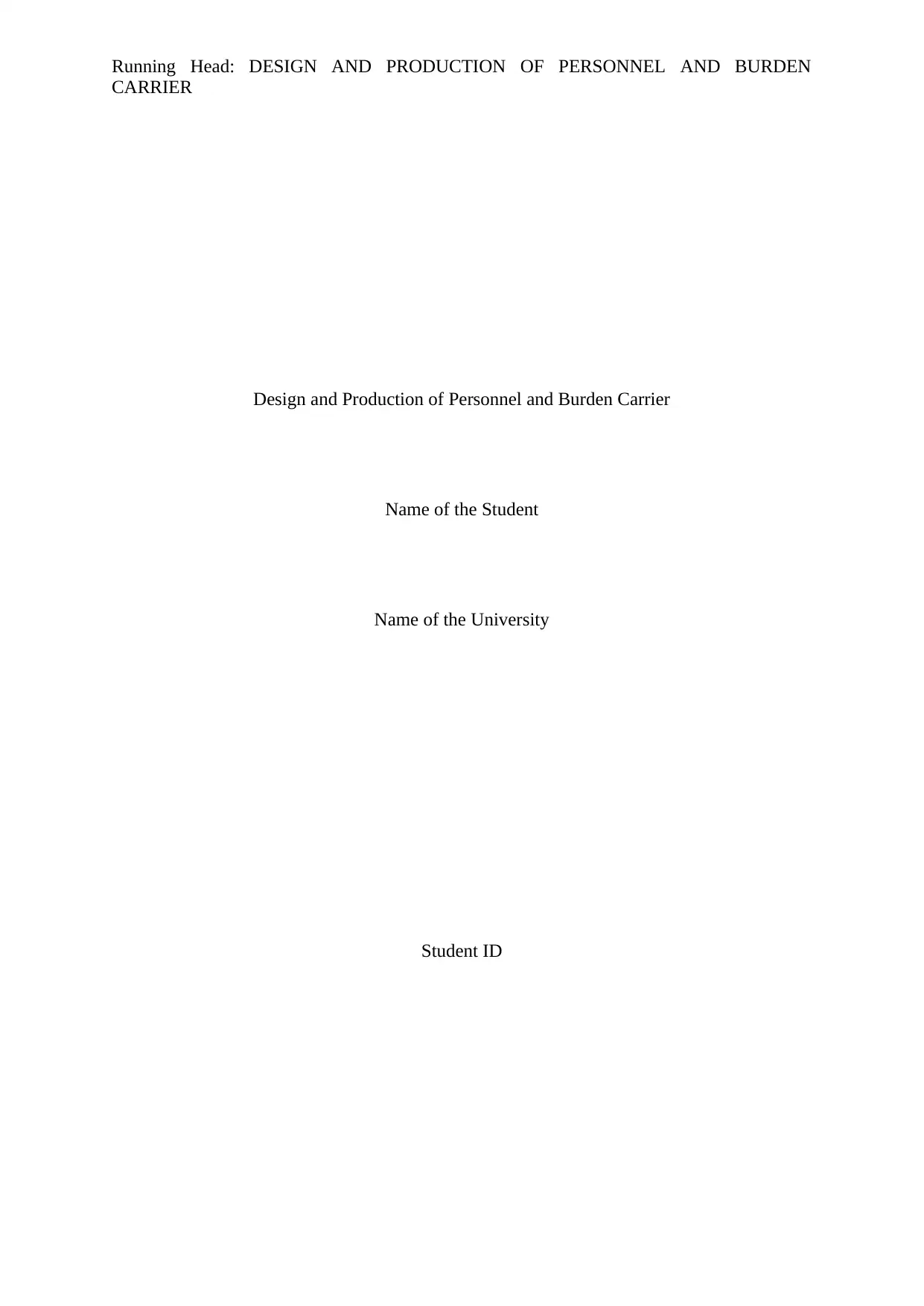
CARRIER
Design and Production of Personnel and Burden Carrier
Name of the Student
Name of the University
Student ID
Paraphrase This Document

Executive Summary
The aim of this study is to revolve around the Cannodale Cycle. This type of cycle is powered
by batteries and is made available to the general users with the help of the local market. This
mainly aims towards the different ways in which the product can be manufactured and
marketed to the consumers. This has been discussed all over in this study.
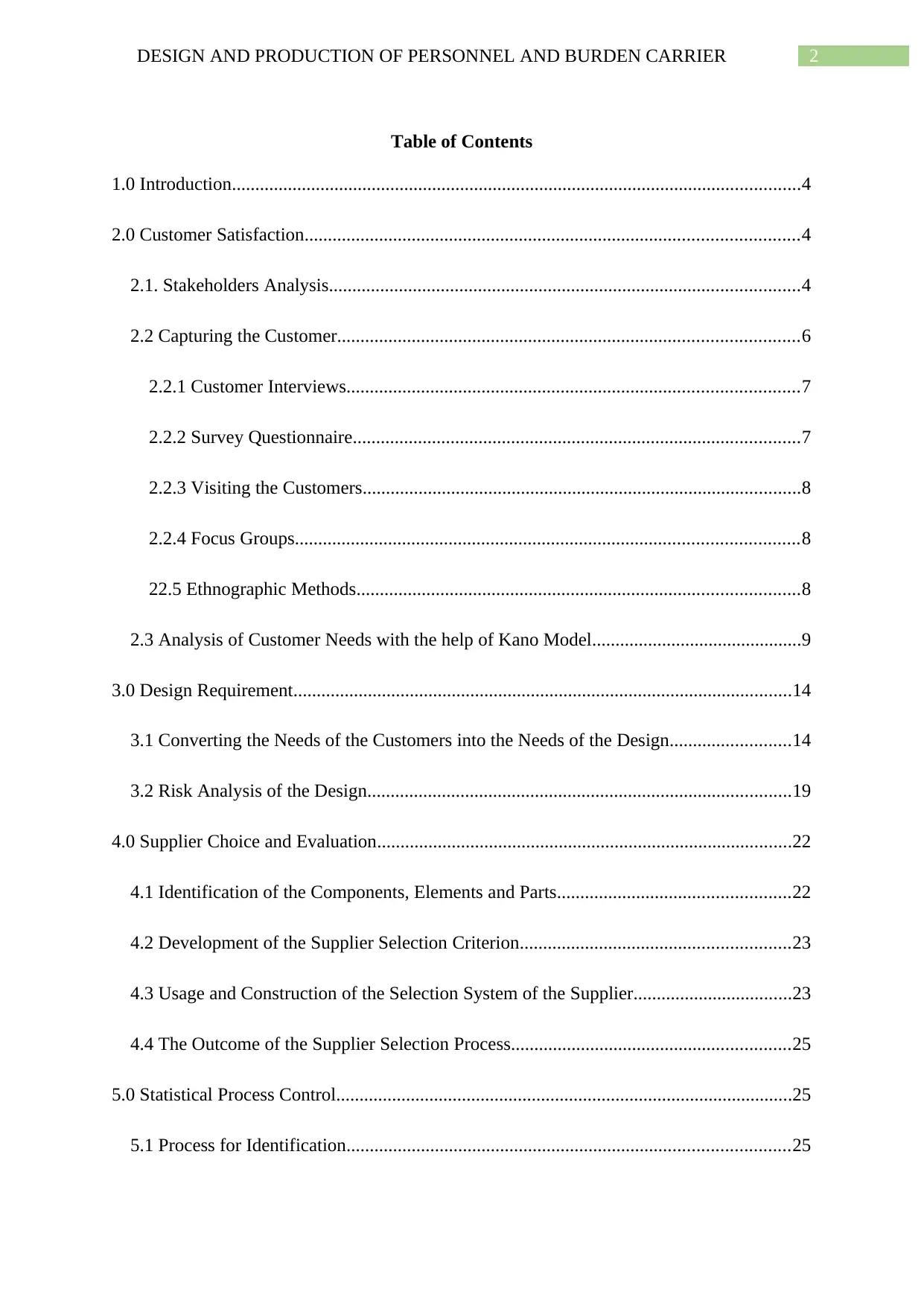
Table of Contents
1.0 Introduction..........................................................................................................................4
2.0 Customer Satisfaction..........................................................................................................4
2.1. Stakeholders Analysis.....................................................................................................4
2.2 Capturing the Customer...................................................................................................6
2.2.1 Customer Interviews.................................................................................................7
2.2.2 Survey Questionnaire................................................................................................7
2.2.3 Visiting the Customers..............................................................................................8
2.2.4 Focus Groups............................................................................................................8
22.5 Ethnographic Methods...............................................................................................8
2.3 Analysis of Customer Needs with the help of Kano Model.............................................9
3.0 Design Requirement...........................................................................................................14
3.1 Converting the Needs of the Customers into the Needs of the Design..........................14
3.2 Risk Analysis of the Design...........................................................................................19
4.0 Supplier Choice and Evaluation.........................................................................................22
4.1 Identification of the Components, Elements and Parts..................................................22
4.2 Development of the Supplier Selection Criterion..........................................................23
4.3 Usage and Construction of the Selection System of the Supplier..................................23
4.4 The Outcome of the Supplier Selection Process............................................................25
5.0 Statistical Process Control..................................................................................................25
5.1 Process for Identification...............................................................................................25
⊘ This is a preview!⊘
Do you want full access?
Subscribe today to unlock all pages.

Trusted by 1+ million students worldwide
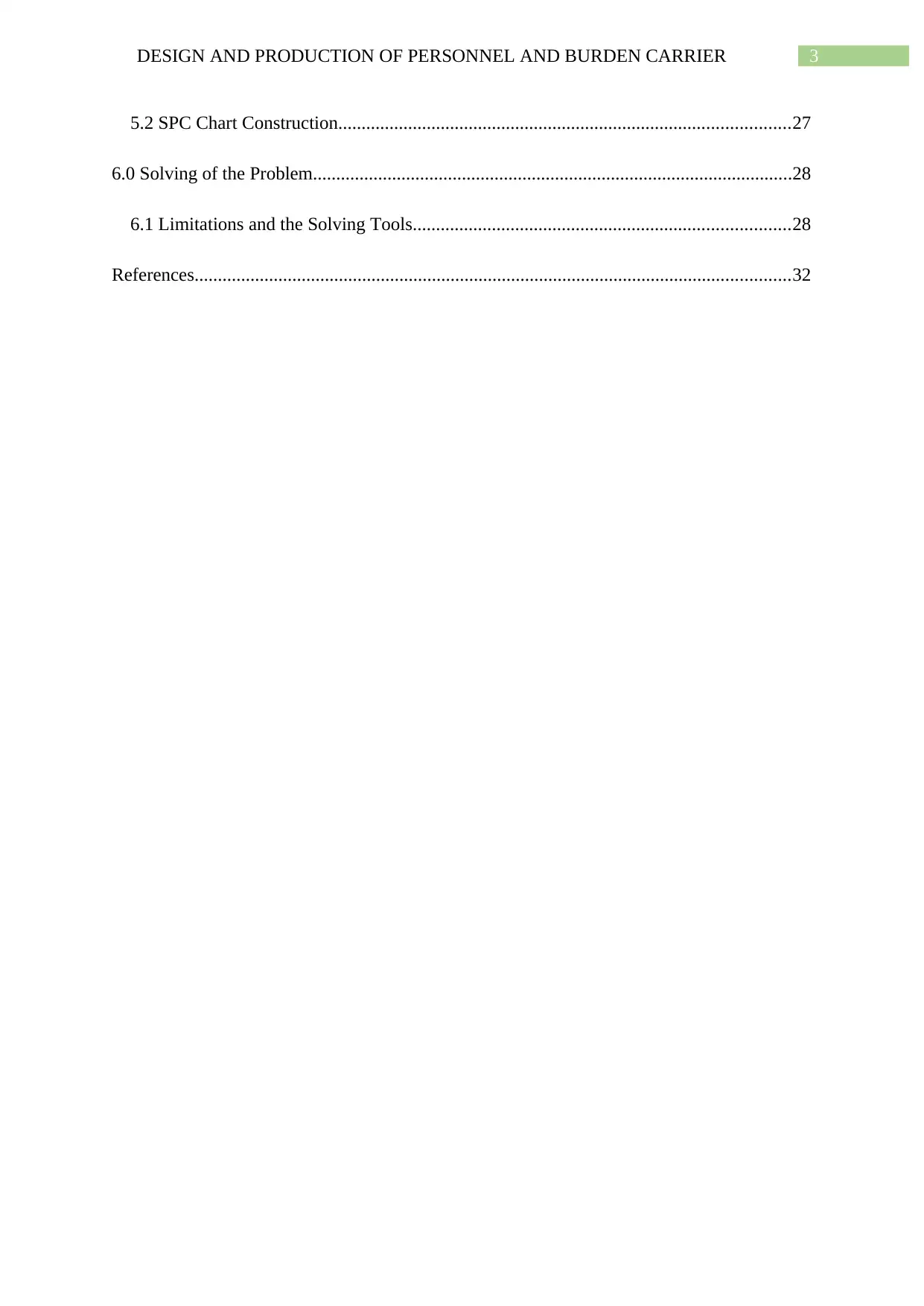
5.2 SPC Chart Construction.................................................................................................27
6.0 Solving of the Problem.......................................................................................................28
6.1 Limitations and the Solving Tools.................................................................................28
References................................................................................................................................32
Paraphrase This Document

1.0 Introduction
There are a lot of different contexts to this report. Each of the contexts are focused on
the operations that are conducted for the Cannondale Bicycles which is mainly based on the
country Australia (Foropon and McLachlin 2013). In general, the mechanism of a bicycle
involves a vehicle with a single track and a pedal; which is powered by humans (Bromiley
and Rau 2016). With the advancement of time and technology, bicycles have been seen to
adopt and improve the initial workings of the machines (Gunasekaran and Irani 2014).
2.0 Customer Satisfaction
2.1. Stakeholders Analysis
It has been identified that the major role is played by the efficiency in planning about
the business either to have association in the production of superchargers of high-end or
having a hand in hand business of nuts and bolts qualities and customer satisfactions (Hitt,
Xu and Carnes 2016).
Table 1: Analysis Chart on Stakeholders
Stakeholder Prospects
Cannondale Department Investment is made and profit is received
for the research
The venture of profit is shared
Engineers Improvement of technology
Enhancement of technology with bigger
investment
Shareholders Investment and Profit
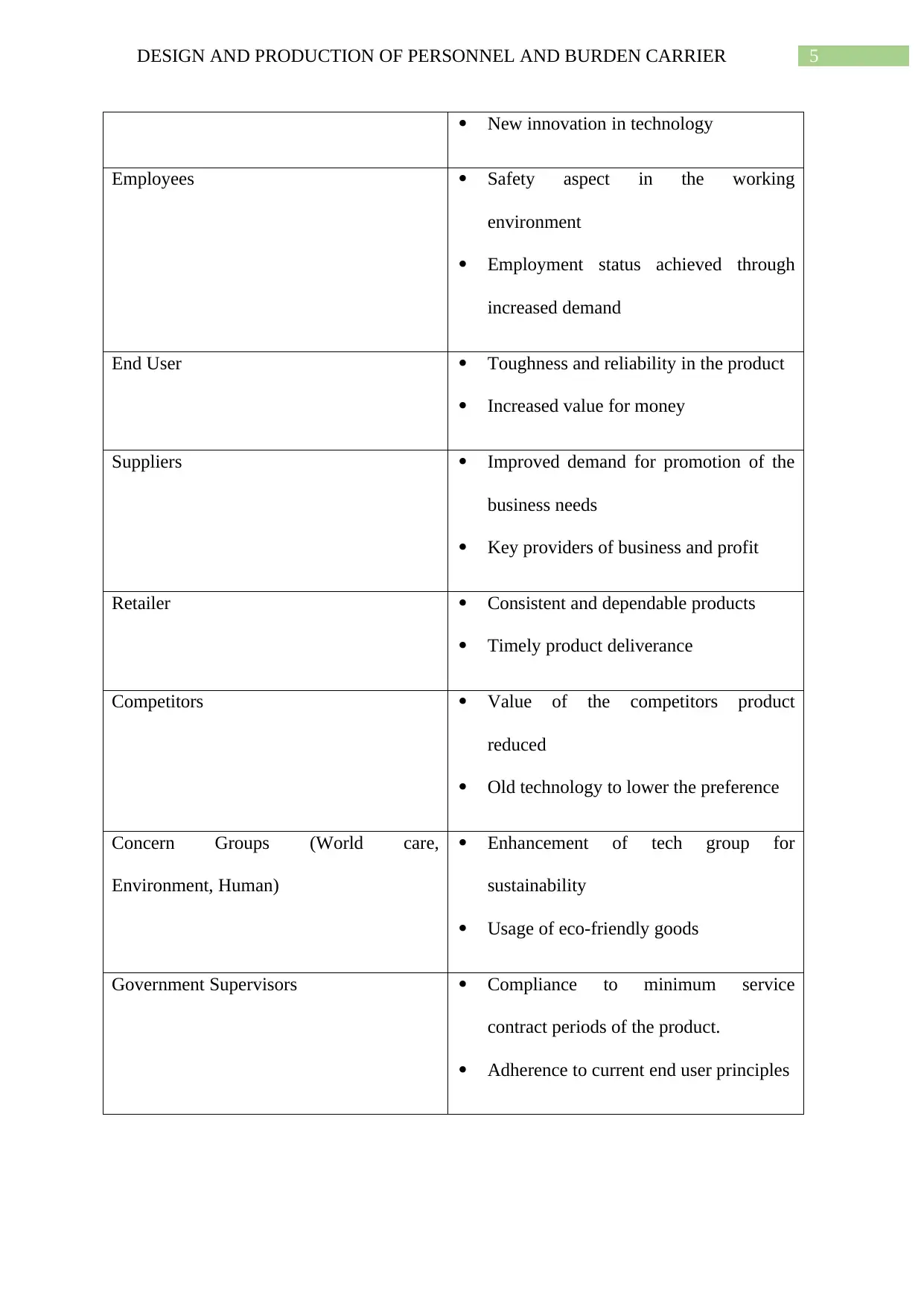
New innovation in technology
Employees Safety aspect in the working
environment
Employment status achieved through
increased demand
End User Toughness and reliability in the product
Increased value for money
Suppliers Improved demand for promotion of the
business needs
Key providers of business and profit
Retailer Consistent and dependable products
Timely product deliverance
Competitors Value of the competitors product
reduced
Old technology to lower the preference
Concern Groups (World care,
Environment, Human)
Enhancement of tech group for
sustainability
Usage of eco-friendly goods
Government Supervisors Compliance to minimum service
contract periods of the product.
Adherence to current end user principles
⊘ This is a preview!⊘
Do you want full access?
Subscribe today to unlock all pages.

Trusted by 1+ million students worldwide
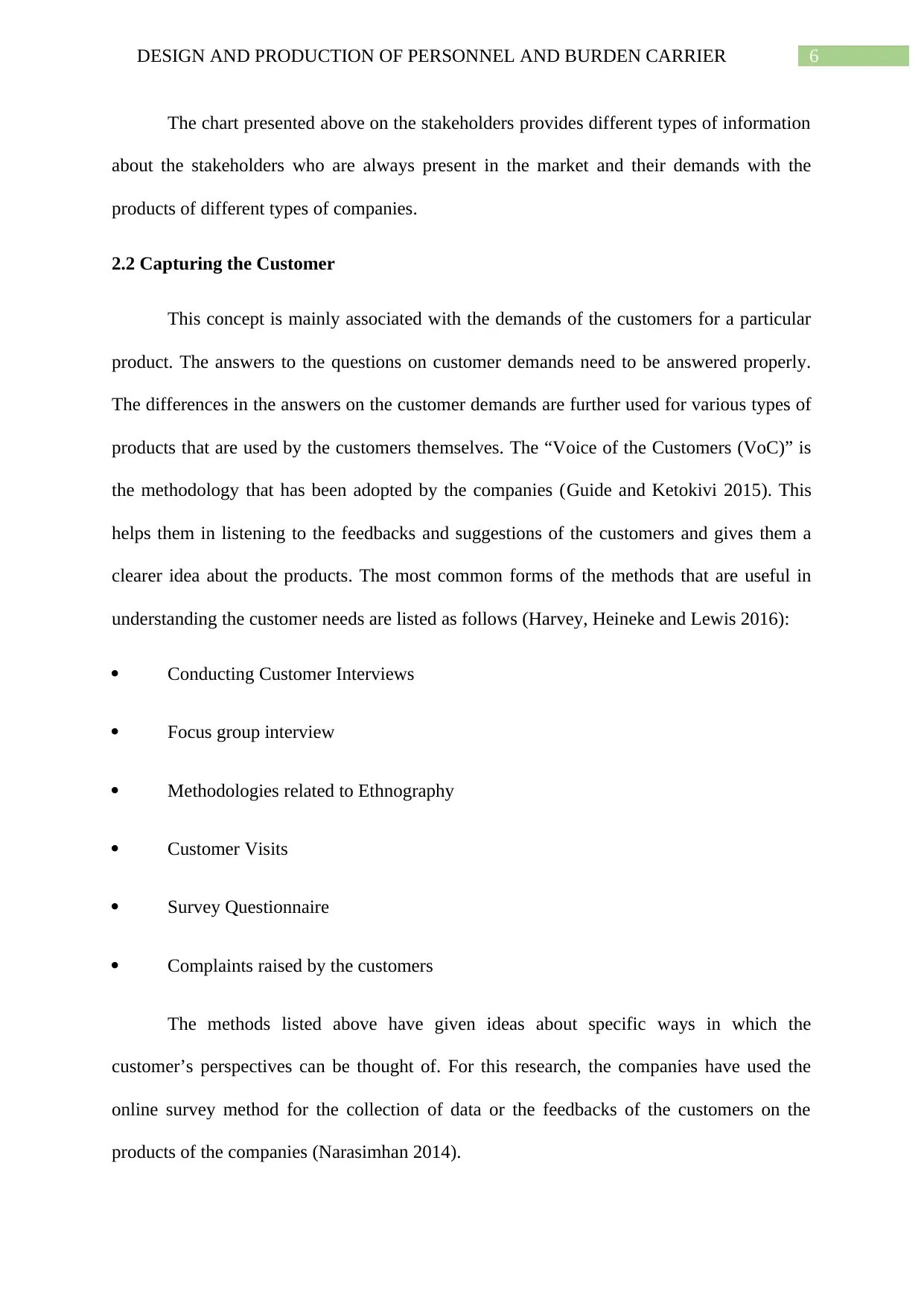
The chart presented above on the stakeholders provides different types of information
about the stakeholders who are always present in the market and their demands with the
products of different types of companies.
2.2 Capturing the Customer
This concept is mainly associated with the demands of the customers for a particular
product. The answers to the questions on customer demands need to be answered properly.
The differences in the answers on the customer demands are further used for various types of
products that are used by the customers themselves. The “Voice of the Customers (VoC)” is
the methodology that has been adopted by the companies (Guide and Ketokivi 2015). This
helps them in listening to the feedbacks and suggestions of the customers and gives them a
clearer idea about the products. The most common forms of the methods that are useful in
understanding the customer needs are listed as follows (Harvey, Heineke and Lewis 2016):
Conducting Customer Interviews
Focus group interview
Methodologies related to Ethnography
Customer Visits
Survey Questionnaire
Complaints raised by the customers
The methods listed above have given ideas about specific ways in which the
customer’s perspectives can be thought of. For this research, the companies have used the
online survey method for the collection of data or the feedbacks of the customers on the
products of the companies (Narasimhan 2014).
Paraphrase This Document

In receiving the feedbacks of the customers and collecting information about the
products that are important, SWOT analysis has been performed which has played a very
important role in the collection and the analysis (Katsikopoulos and Gigerenzer 2013). This
analysis also highlights the areas in which developments are necessary and also the areas in
which the companies are performing better (Machado et al 2017).
2.2.1 Customer Interviews
Interviewing customers is the primary step that a company should adopt if the
company is interested in valuing the customer feedbacks on its products. In order to conduct
these interviews, questionnaires are prepared which contains questions about various types of
specifications that are necessary for the customers to answer truthfully. The interviews can be
conducted in groups or individually. The interview can further be conducted with the help of
the web or by having a chat face to face. The changes in the medium of interview does not
affect the outcome of the interview (Pedraza-Martinez and Van Wassenhove 2016).
There are a lot of ways in which a questionnaire can be prepared and the methods are
independent. The methods are adopted from individual platforms. This differs mostly based
on the set of the questionnaires specifically and the subjects of customer satisfaction on
which the questionnaires are made. It has also been observed that the comfortability of a
customer is very important for the database of the company (Rosenhead 2013).
The capability of qualitative data and quantitative data can also be evaluated with the
help of this interview method. Various circumstances have been faced based on the reports
made from this data collection method (Phan and Chambers 2013). At times, scanning of
these reports might also result in obtaining the wrong feedbacks. Thus, an individual has
always to be prepared with the risks that can occur by considering various factors (Plambeck
2013).
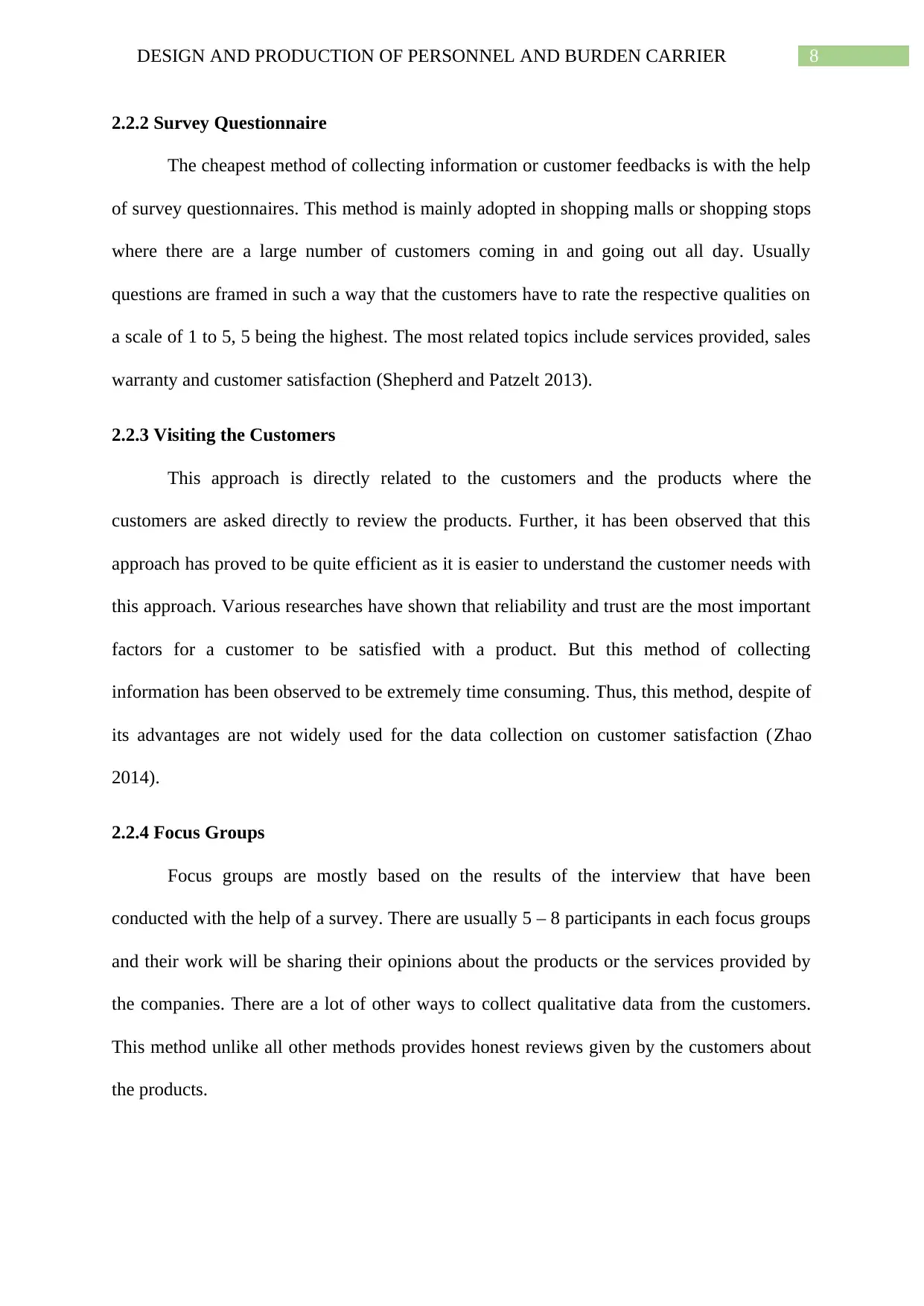
2.2.2 Survey Questionnaire
The cheapest method of collecting information or customer feedbacks is with the help
of survey questionnaires. This method is mainly adopted in shopping malls or shopping stops
where there are a large number of customers coming in and going out all day. Usually
questions are framed in such a way that the customers have to rate the respective qualities on
a scale of 1 to 5, 5 being the highest. The most related topics include services provided, sales
warranty and customer satisfaction (Shepherd and Patzelt 2013).
2.2.3 Visiting the Customers
This approach is directly related to the customers and the products where the
customers are asked directly to review the products. Further, it has been observed that this
approach has proved to be quite efficient as it is easier to understand the customer needs with
this approach. Various researches have shown that reliability and trust are the most important
factors for a customer to be satisfied with a product. But this method of collecting
information has been observed to be extremely time consuming. Thus, this method, despite of
its advantages are not widely used for the data collection on customer satisfaction (Zhao
2014).
2.2.4 Focus Groups
Focus groups are mostly based on the results of the interview that have been
conducted with the help of a survey. There are usually 5 – 8 participants in each focus groups
and their work will be sharing their opinions about the products or the services provided by
the companies. There are a lot of other ways to collect qualitative data from the customers.
This method unlike all other methods provides honest reviews given by the customers about
the products.
⊘ This is a preview!⊘
Do you want full access?
Subscribe today to unlock all pages.

Trusted by 1+ million students worldwide
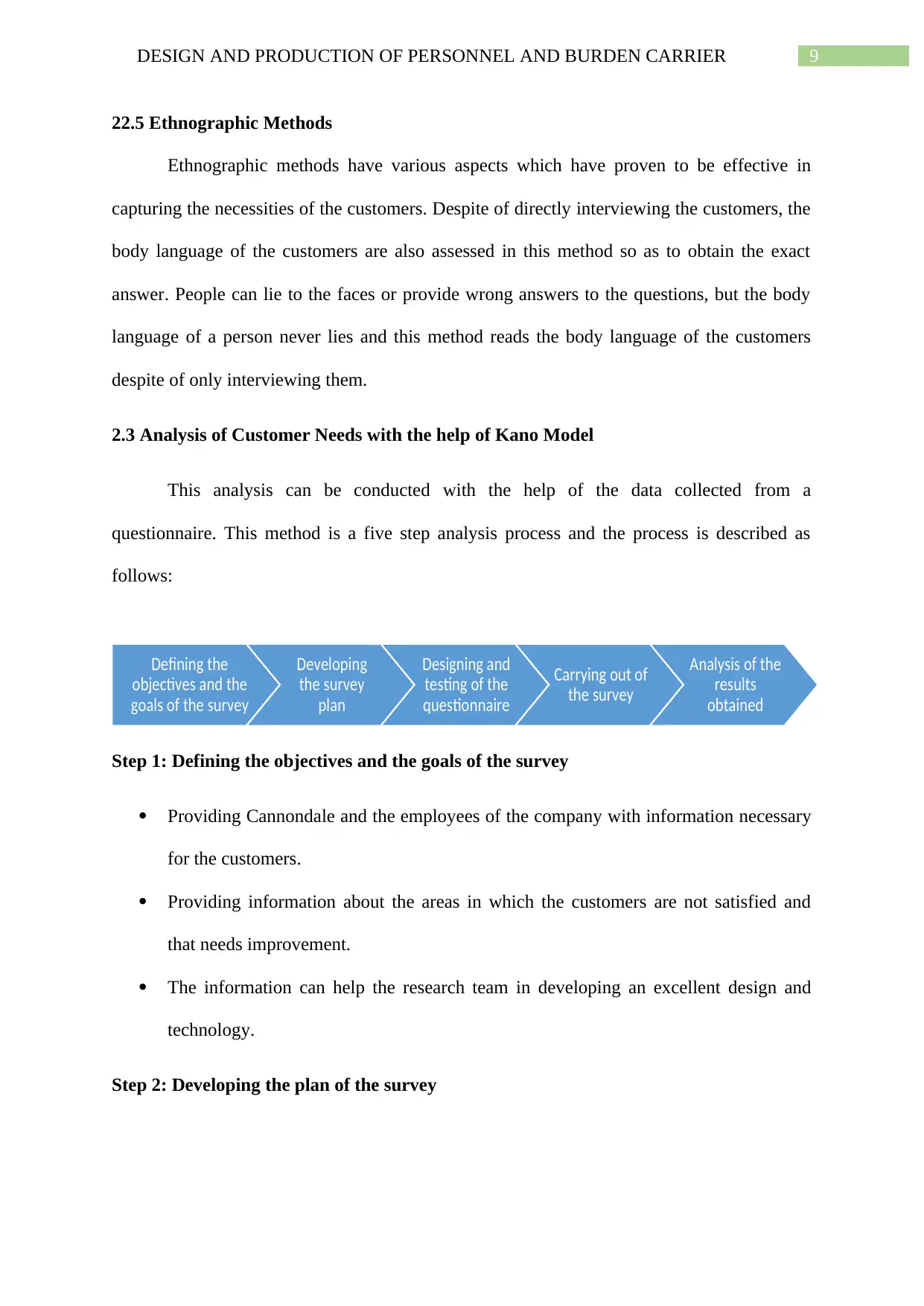
22.5 Ethnographic Methods
Ethnographic methods have various aspects which have proven to be effective in
capturing the necessities of the customers. Despite of directly interviewing the customers, the
body language of the customers are also assessed in this method so as to obtain the exact
answer. People can lie to the faces or provide wrong answers to the questions, but the body
language of a person never lies and this method reads the body language of the customers
despite of only interviewing them.
2.3 Analysis of Customer Needs with the help of Kano Model
This analysis can be conducted with the help of the data collected from a
questionnaire. This method is a five step analysis process and the process is described as
follows:
Step 1: Defining the objectives and the goals of the survey
Providing Cannondale and the employees of the company with information necessary
for the customers.
Providing information about the areas in which the customers are not satisfied and
that needs improvement.
The information can help the research team in developing an excellent design and
technology.
Step 2: Developing the plan of the survey
Defining the
objectives and the
goals of the survey
Developing
the survey
plan
Designing and
testing of the
questionnaire
Carrying out of
the survey
Analysis of the
results
obtained
Paraphrase This Document
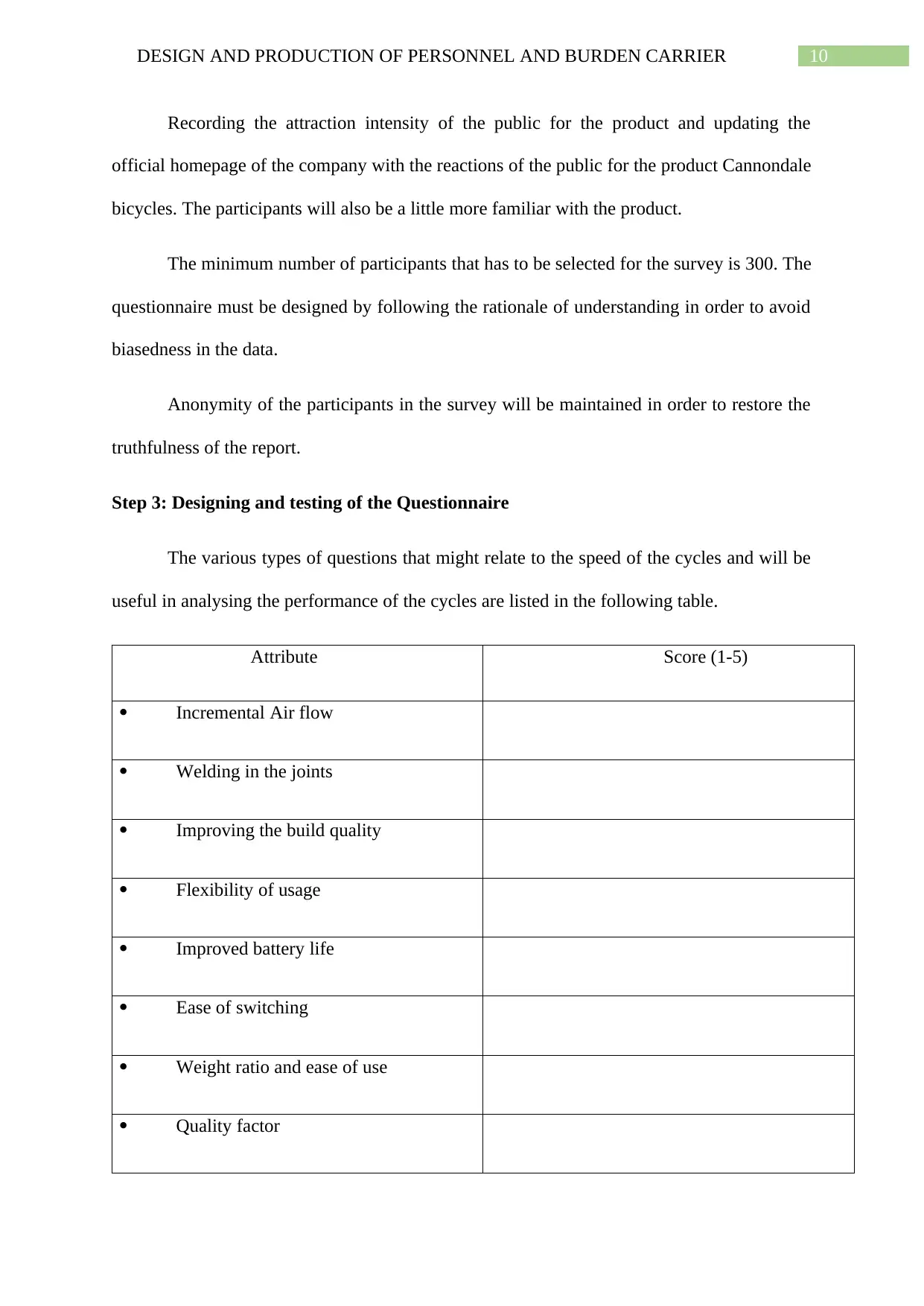
Recording the attraction intensity of the public for the product and updating the
official homepage of the company with the reactions of the public for the product Cannondale
bicycles. The participants will also be a little more familiar with the product.
The minimum number of participants that has to be selected for the survey is 300. The
questionnaire must be designed by following the rationale of understanding in order to avoid
biasedness in the data.
Anonymity of the participants in the survey will be maintained in order to restore the
truthfulness of the report.
Step 3: Designing and testing of the Questionnaire
The various types of questions that might relate to the speed of the cycles and will be
useful in analysing the performance of the cycles are listed in the following table.
Attribute Score (1-5)
Incremental Air flow
Welding in the joints
Improving the build quality
Flexibility of usage
Improved battery life
Ease of switching
Weight ratio and ease of use
Quality factor
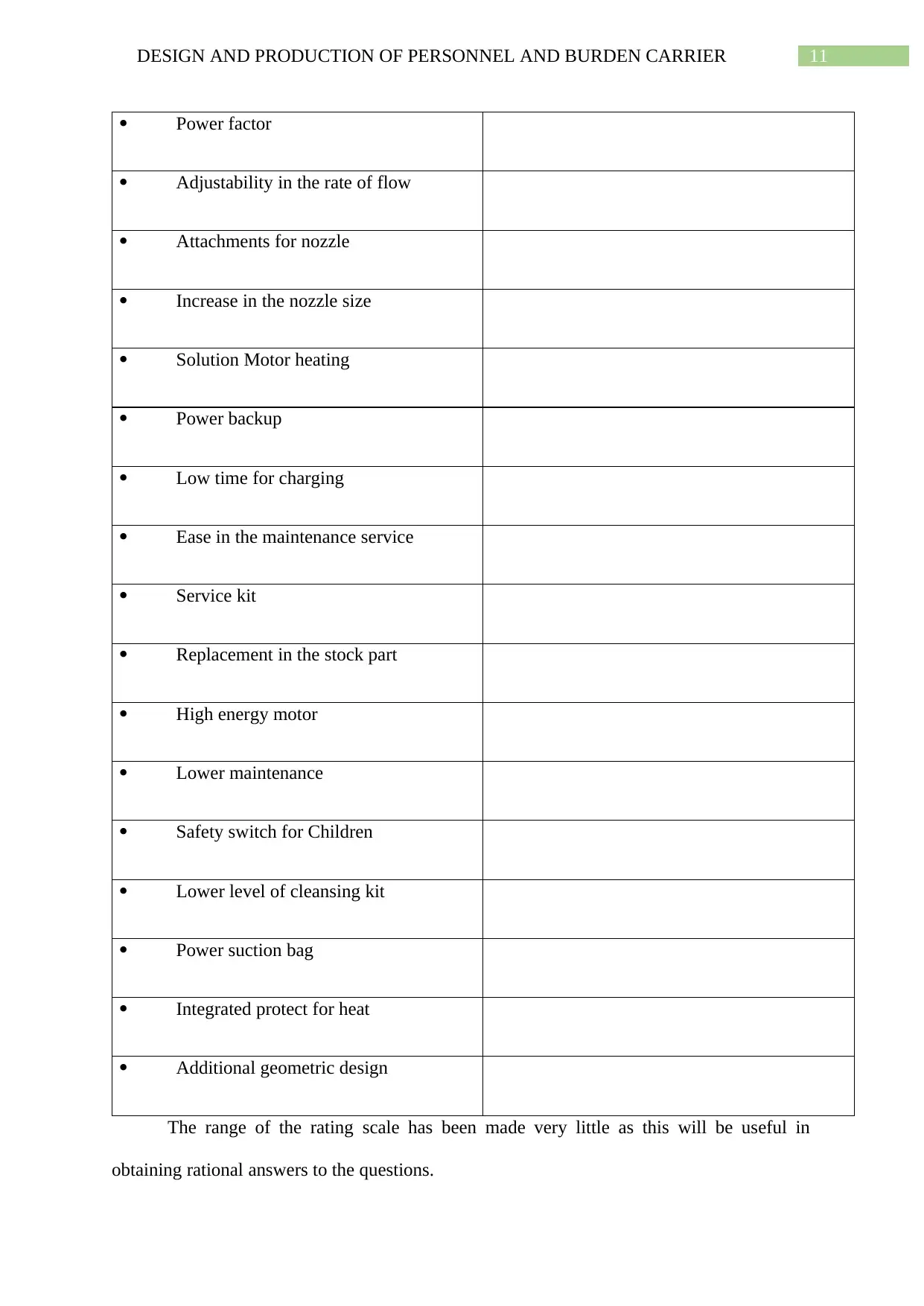
Power factor
Adjustability in the rate of flow
Attachments for nozzle
Increase in the nozzle size
Solution Motor heating
Power backup
Low time for charging
Ease in the maintenance service
Service kit
Replacement in the stock part
High energy motor
Lower maintenance
Safety switch for Children
Lower level of cleansing kit
Power suction bag
Integrated protect for heat
Additional geometric design
The range of the rating scale has been made very little as this will be useful in
obtaining rational answers to the questions.
⊘ This is a preview!⊘
Do you want full access?
Subscribe today to unlock all pages.

Trusted by 1+ million students worldwide
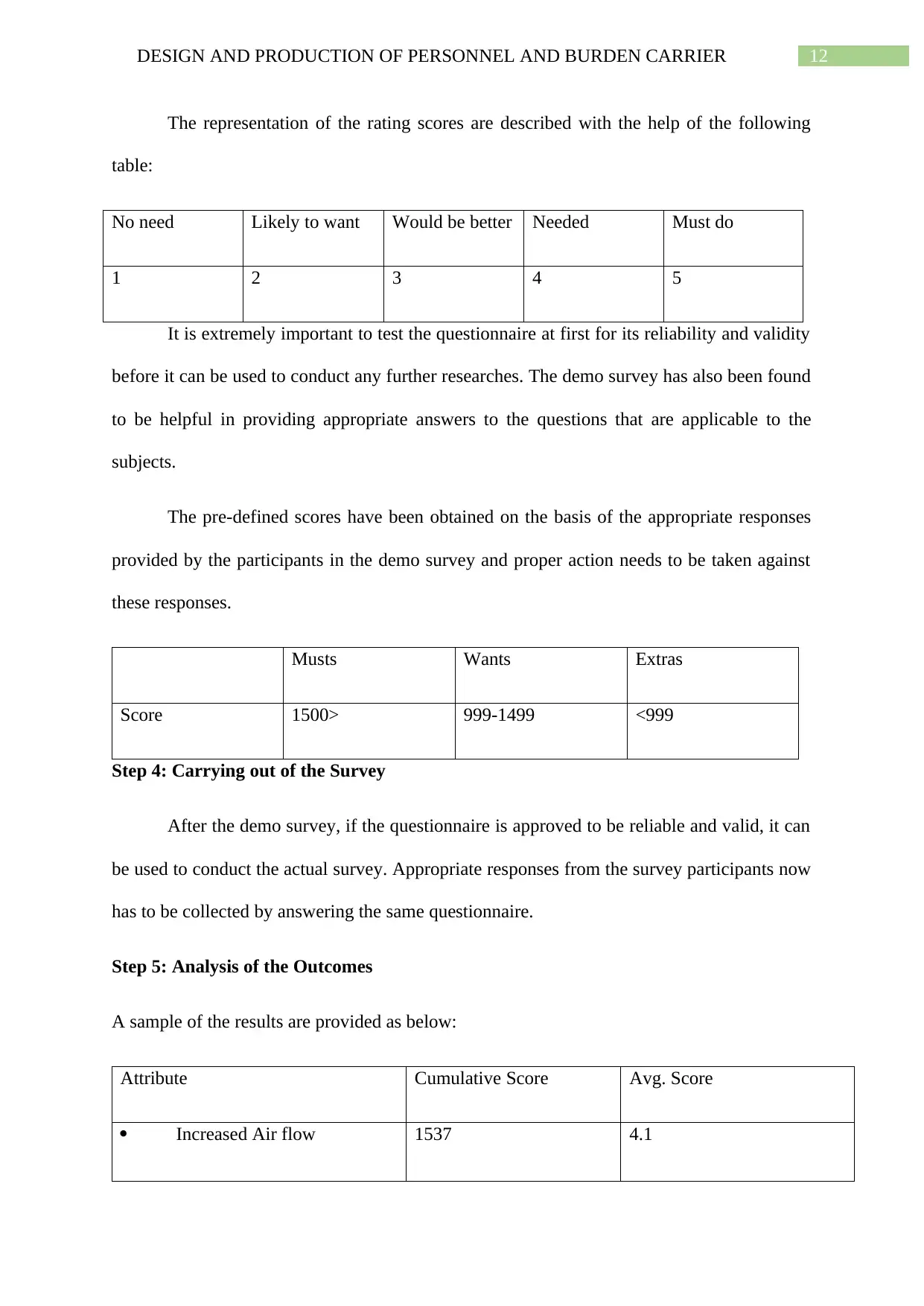
The representation of the rating scores are described with the help of the following
table:
No need Likely to want Would be better Needed Must do
1 2 3 4 5
It is extremely important to test the questionnaire at first for its reliability and validity
before it can be used to conduct any further researches. The demo survey has also been found
to be helpful in providing appropriate answers to the questions that are applicable to the
subjects.
The pre-defined scores have been obtained on the basis of the appropriate responses
provided by the participants in the demo survey and proper action needs to be taken against
these responses.
Musts Wants Extras
Score 1500> 999-1499 <999
Step 4: Carrying out of the Survey
After the demo survey, if the questionnaire is approved to be reliable and valid, it can
be used to conduct the actual survey. Appropriate responses from the survey participants now
has to be collected by answering the same questionnaire.
Step 5: Analysis of the Outcomes
A sample of the results are provided as below:
Attribute Cumulative Score Avg. Score
Increased Air flow 1537 4.1
Paraphrase This Document

Weld the joints 1439 3.9
Improving the build quality 1583 4.2
Flexibility of use 1585 4.2
Improved battery life 1561 4.2
Ease of switching 1633 4.4
Weight ratio and ease of use 1657 4.5
Quality factor 1564 4.6
Power factor 1534 4.1
Adjustability in the rate of
flow
1582 4.2
Nozzle Attachment 1175 3.2
Increase in the nozzle size 1009 2.7
Motor heating to be solved 1085 2.9
Power backup 1205 3.0
Low time for charging 1225 3.3
Ease in the preservation
service
1039 2.8
Servicing Kit 1129 2.9
Replacement in the stock part 1177 3.8
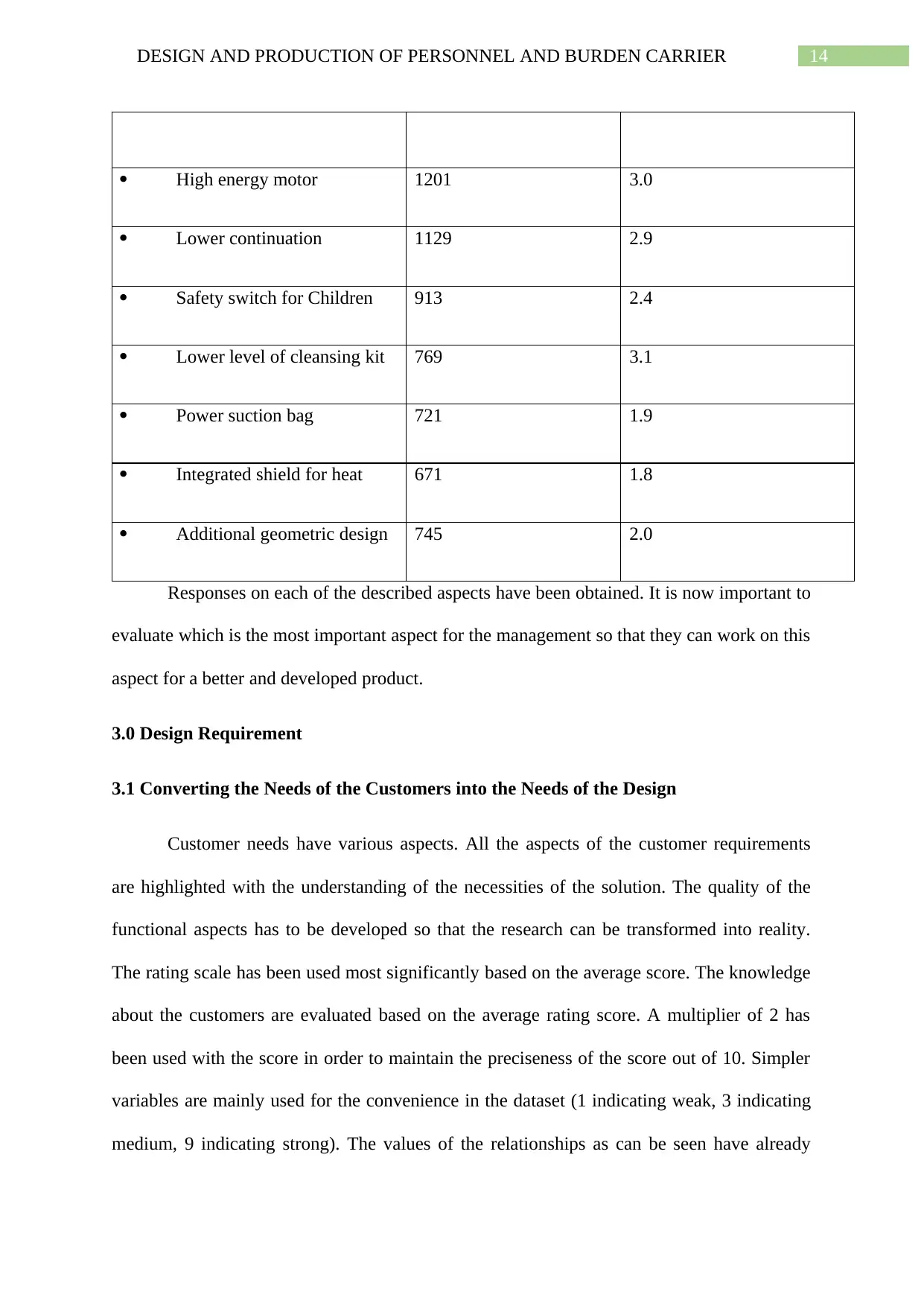
High energy motor 1201 3.0
Lower continuation 1129 2.9
Safety switch for Children 913 2.4
Lower level of cleansing kit 769 3.1
Power suction bag 721 1.9
Integrated shield for heat 671 1.8
Additional geometric design 745 2.0
Responses on each of the described aspects have been obtained. It is now important to
evaluate which is the most important aspect for the management so that they can work on this
aspect for a better and developed product.
3.0 Design Requirement
3.1 Converting the Needs of the Customers into the Needs of the Design
Customer needs have various aspects. All the aspects of the customer requirements
are highlighted with the understanding of the necessities of the solution. The quality of the
functional aspects has to be developed so that the research can be transformed into reality.
The rating scale has been used most significantly based on the average score. The knowledge
about the customers are evaluated based on the average rating score. A multiplier of 2 has
been used with the score in order to maintain the preciseness of the score out of 10. Simpler
variables are mainly used for the convenience in the dataset (1 indicating weak, 3 indicating
medium, 9 indicating strong). The values of the relationships as can be seen have already
⊘ This is a preview!⊘
Do you want full access?
Subscribe today to unlock all pages.

Trusted by 1+ million students worldwide
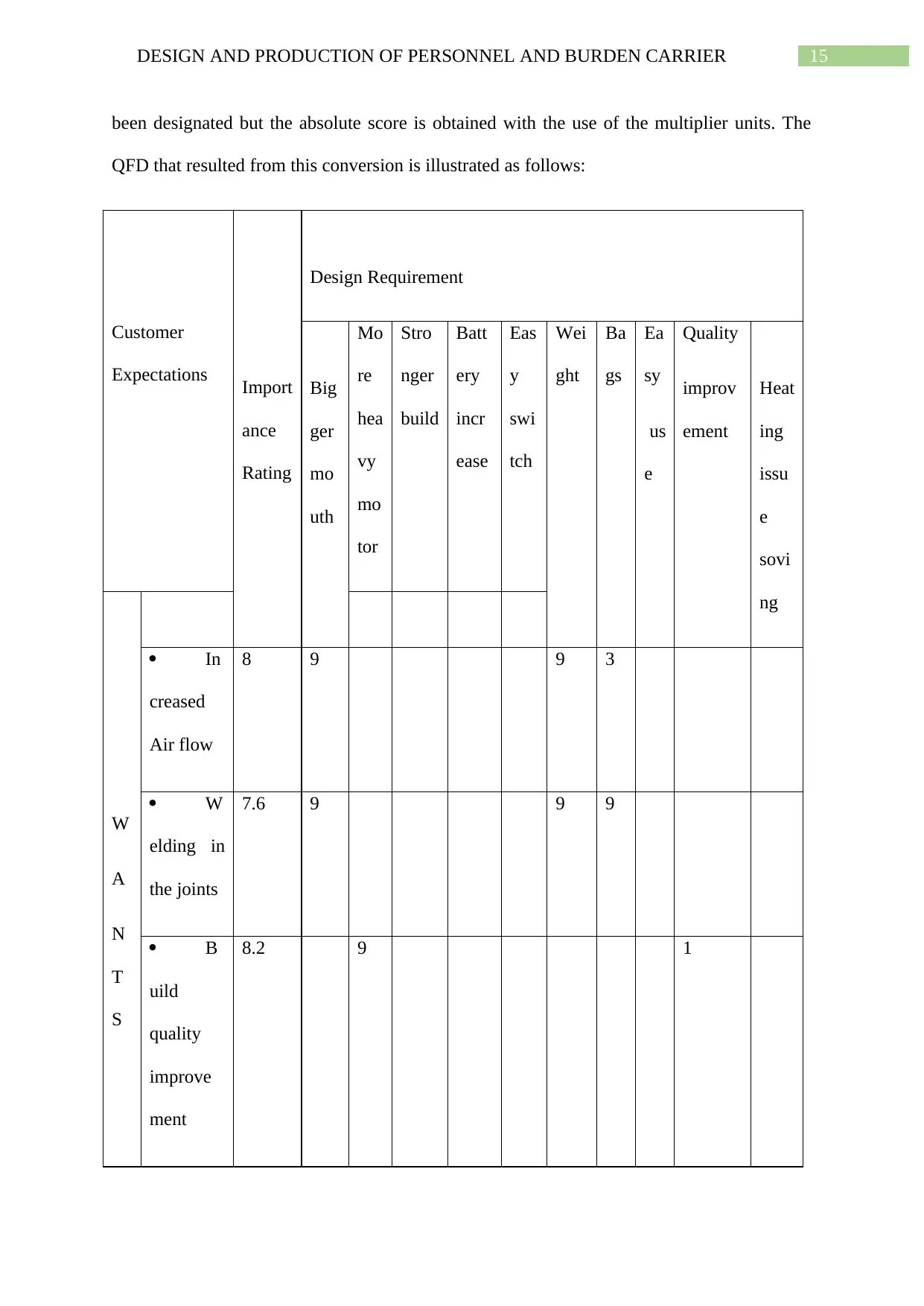
been designated but the absolute score is obtained with the use of the multiplier units. The
QFD that resulted from this conversion is illustrated as follows:
Customer
Expectations Import
ance
Rating
Design Requirement
Big
ger
mo
uth
Mo
re
hea
vy
mo
tor
Stro
nger
build
Batt
ery
incr
ease
Eas
y
swi
tch
Wei
ght
Ba
gs
Ea
sy
us
e
Quality
improv
ement
Heat
ing
issu
e
sovi
ng
W
A
N
T
S
In
creased
Air flow
8 9 9 3
W
elding in
the joints
7.6 9 9 9
B
uild
quality
improve
ment
8.2 9 1
Paraphrase This Document
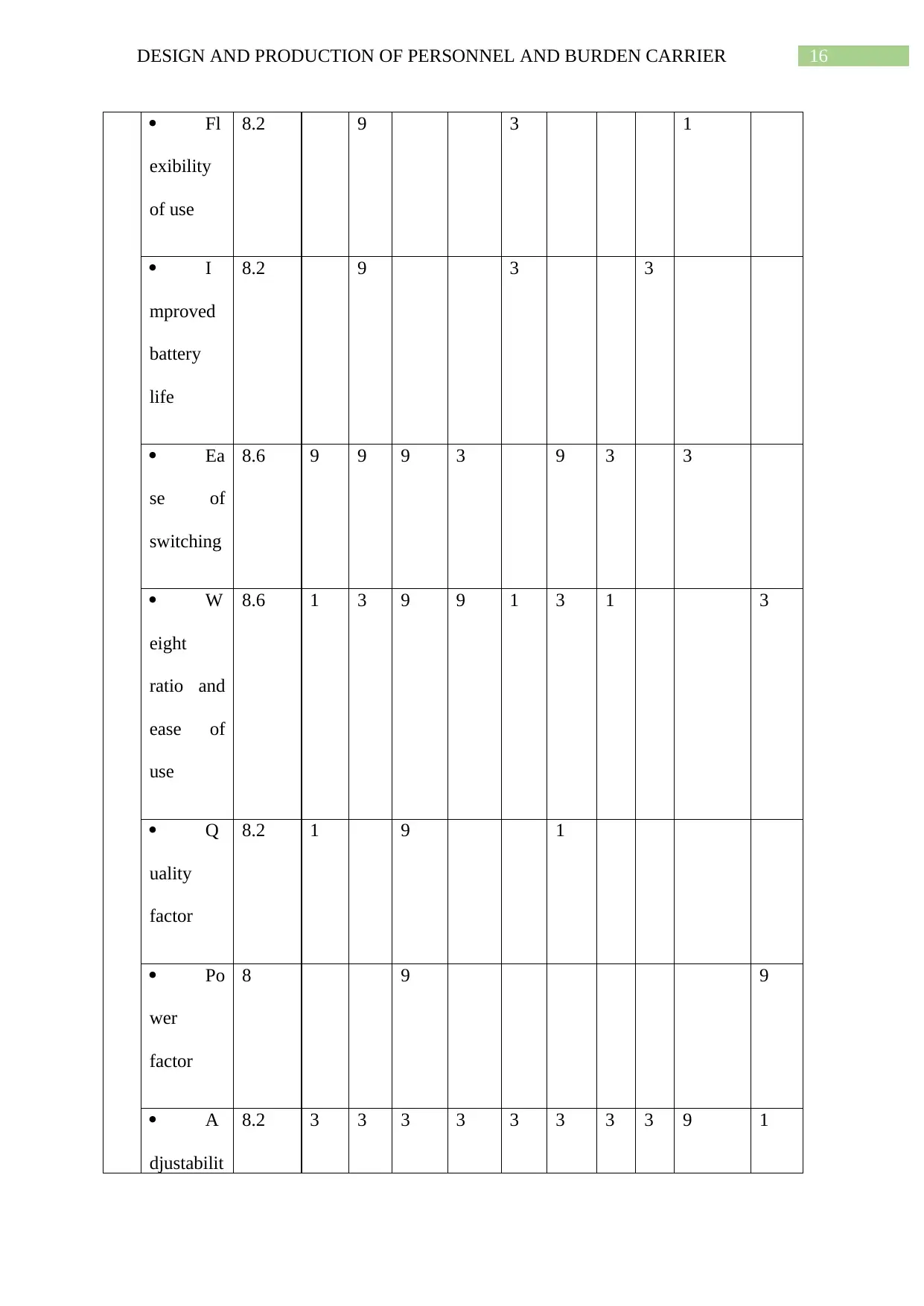
Fl
exibility
of use
8.2 9 3 1
I
mproved
battery
life
8.2 9 3 3
Ea
se of
switching
8.6 9 9 9 3 9 3 3
W
eight
ratio and
ease of
use
8.6 1 3 9 9 1 3 1 3
Q
uality
factor
8.2 1 9 1
Po
wer
factor
8 9 9
A
djustabilit
8.2 3 3 3 3 3 3 3 3 9 1
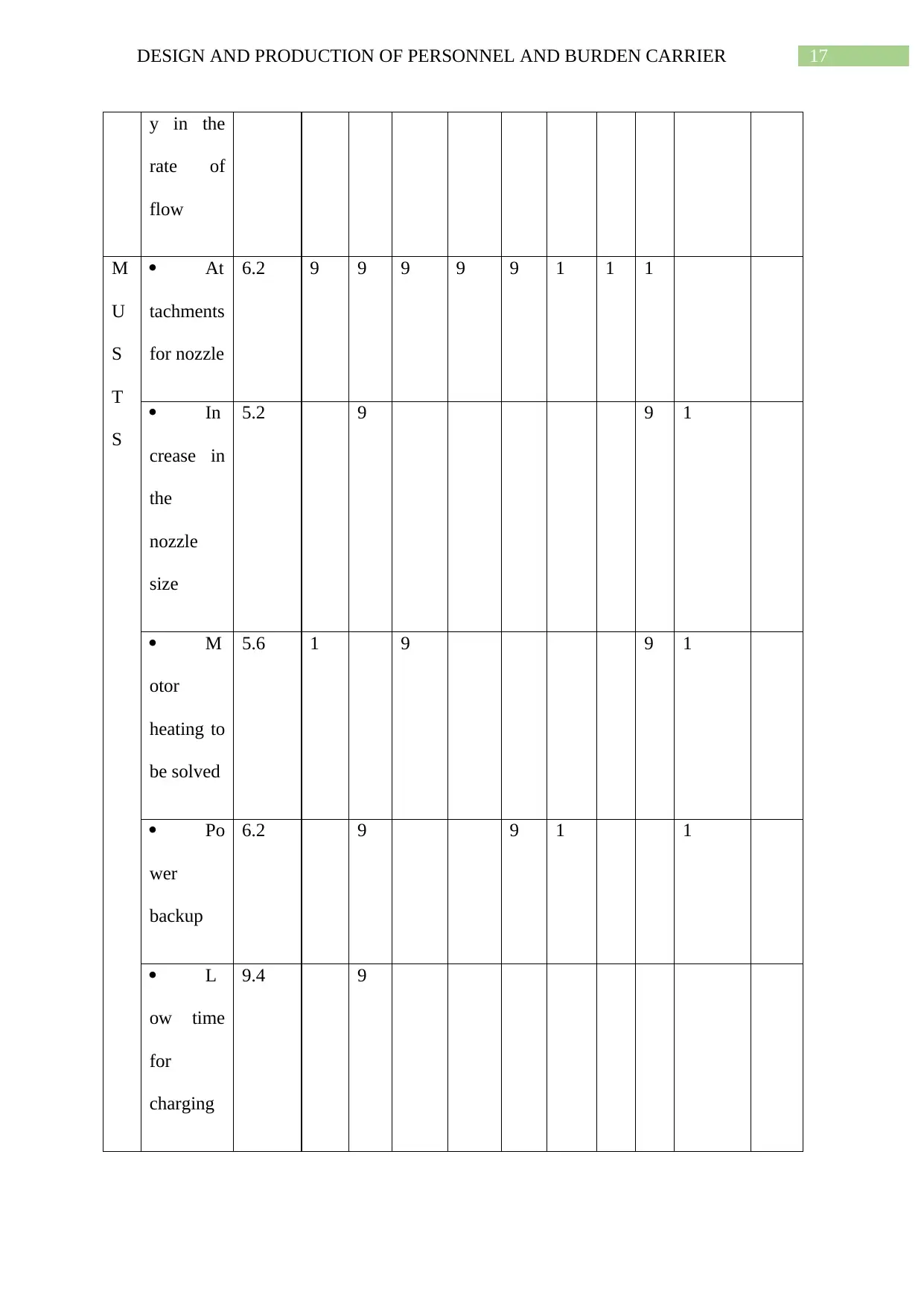
y in the
rate of
flow
M
U
S
T
S
At
tachments
for nozzle
6.2 9 9 9 9 9 1 1 1
In
crease in
the
nozzle
size
5.2 9 9 1
M
otor
heating to
be solved
5.6 1 9 9 1
Po
wer
backup
6.2 9 9 1 1
L
ow time
for
charging
9.4 9
⊘ This is a preview!⊘
Do you want full access?
Subscribe today to unlock all pages.

Trusted by 1+ million students worldwide

Ea
se in the
maintena
nce
service
5.4 9 9 9
Se
rvice kit
5.8 9 9 3 1
R
eplaceme
nt in the
stock part
6.2 9 9 9 9 9 9 9 9
Hi
gh energy
motor
6.2 3 3 9 3 1
L
ower
maintena
nce
5.8 3 9
E
X
T
R
Sa
fety
switch for
Children
4.8 3 9 9 9 3
Paraphrase This Document
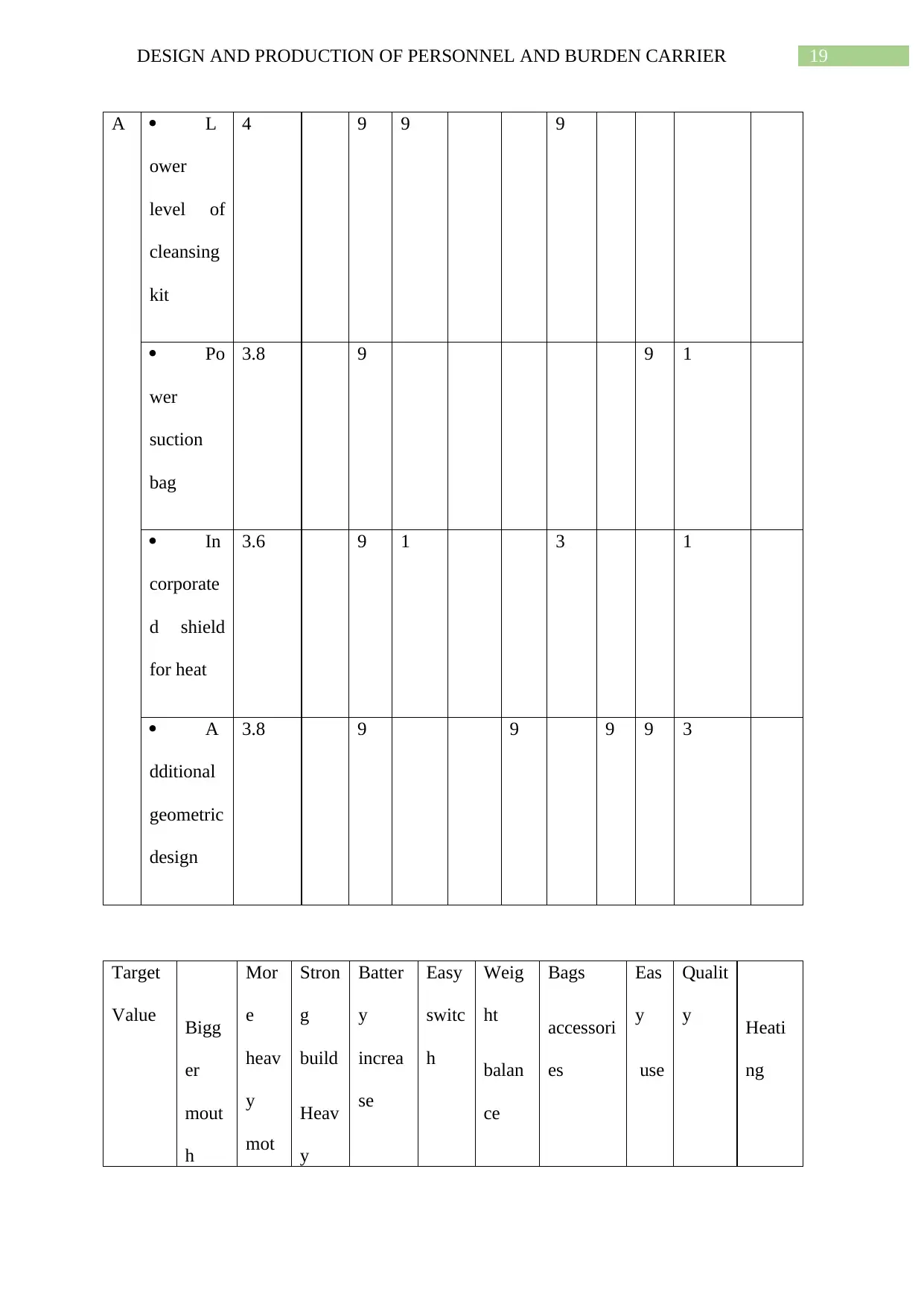
A L
ower
level of
cleansing
kit
4 9 9 9
Po
wer
suction
bag
3.8 9 9 1
In
corporate
d shield
for heat
3.6 9 1 3 1
A
dditional
geometric
design
3.8 9 9 9 9 3
Target
Value Bigg
er
mout
h
Mor
e
heav
y
mot
Stron
g
build
Heav
y
Batter
y
increa
se
Easy
switc
h
Weig
ht
balan
ce
Bags
accessori
es
Eas
y
use
Qualit
y Heati
ng
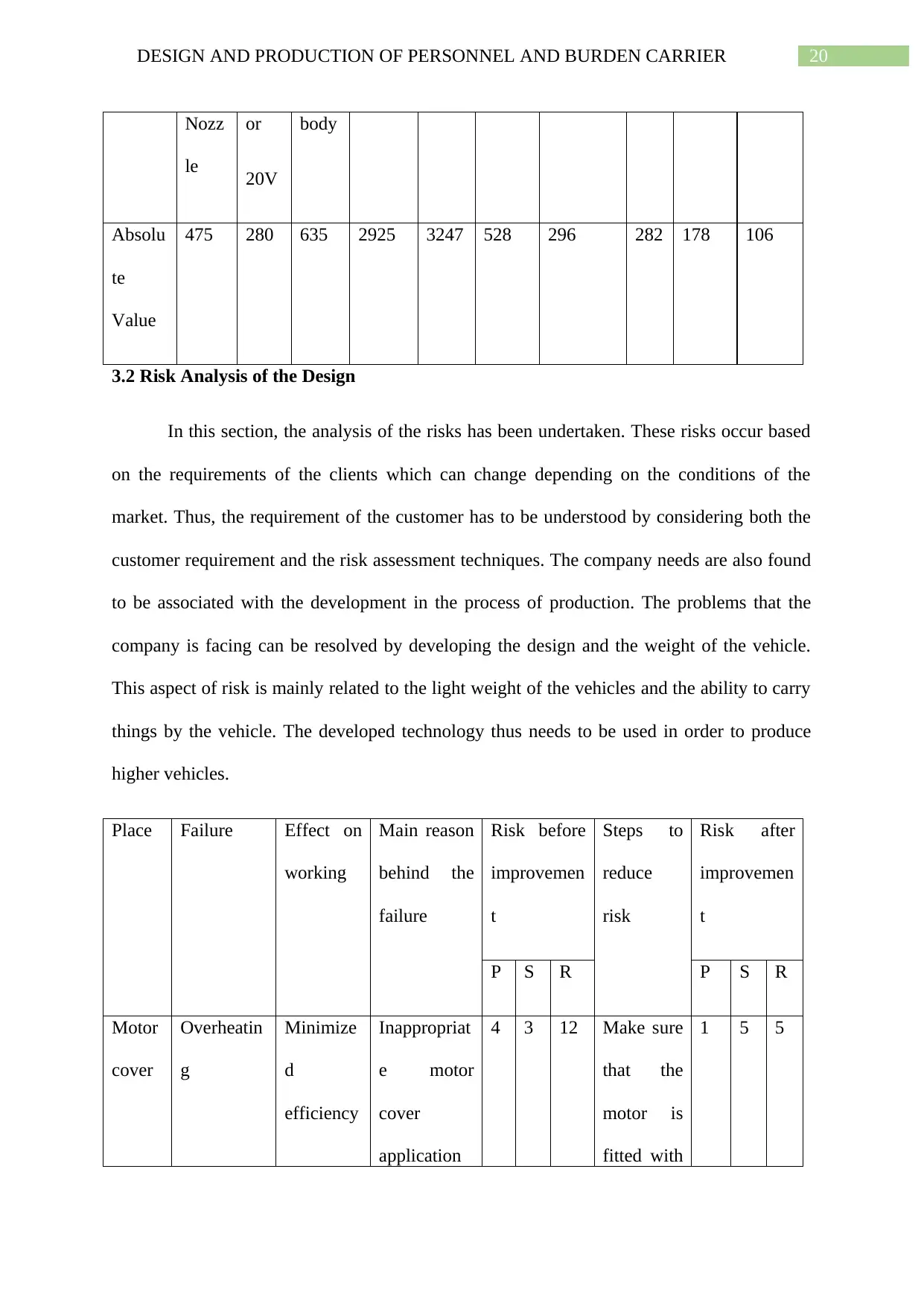
Nozz
le
or
20V
body
Absolu
te
Value
475 280 635 2925 3247 528 296 282 178 106
3.2 Risk Analysis of the Design
In this section, the analysis of the risks has been undertaken. These risks occur based
on the requirements of the clients which can change depending on the conditions of the
market. Thus, the requirement of the customer has to be understood by considering both the
customer requirement and the risk assessment techniques. The company needs are also found
to be associated with the development in the process of production. The problems that the
company is facing can be resolved by developing the design and the weight of the vehicle.
This aspect of risk is mainly related to the light weight of the vehicles and the ability to carry
things by the vehicle. The developed technology thus needs to be used in order to produce
higher vehicles.
Place Failure Effect on
working
Main reason
behind the
failure
Risk before
improvemen
t
Steps to
reduce
risk
Risk after
improvemen
t
P S R P S R
Motor
cover
Overheatin
g
Minimize
d
efficiency
Inappropriat
e motor
cover
application
4 3 12 Make sure
that the
motor is
fitted with
1 5 5
⊘ This is a preview!⊘
Do you want full access?
Subscribe today to unlock all pages.

Trusted by 1+ million students worldwide
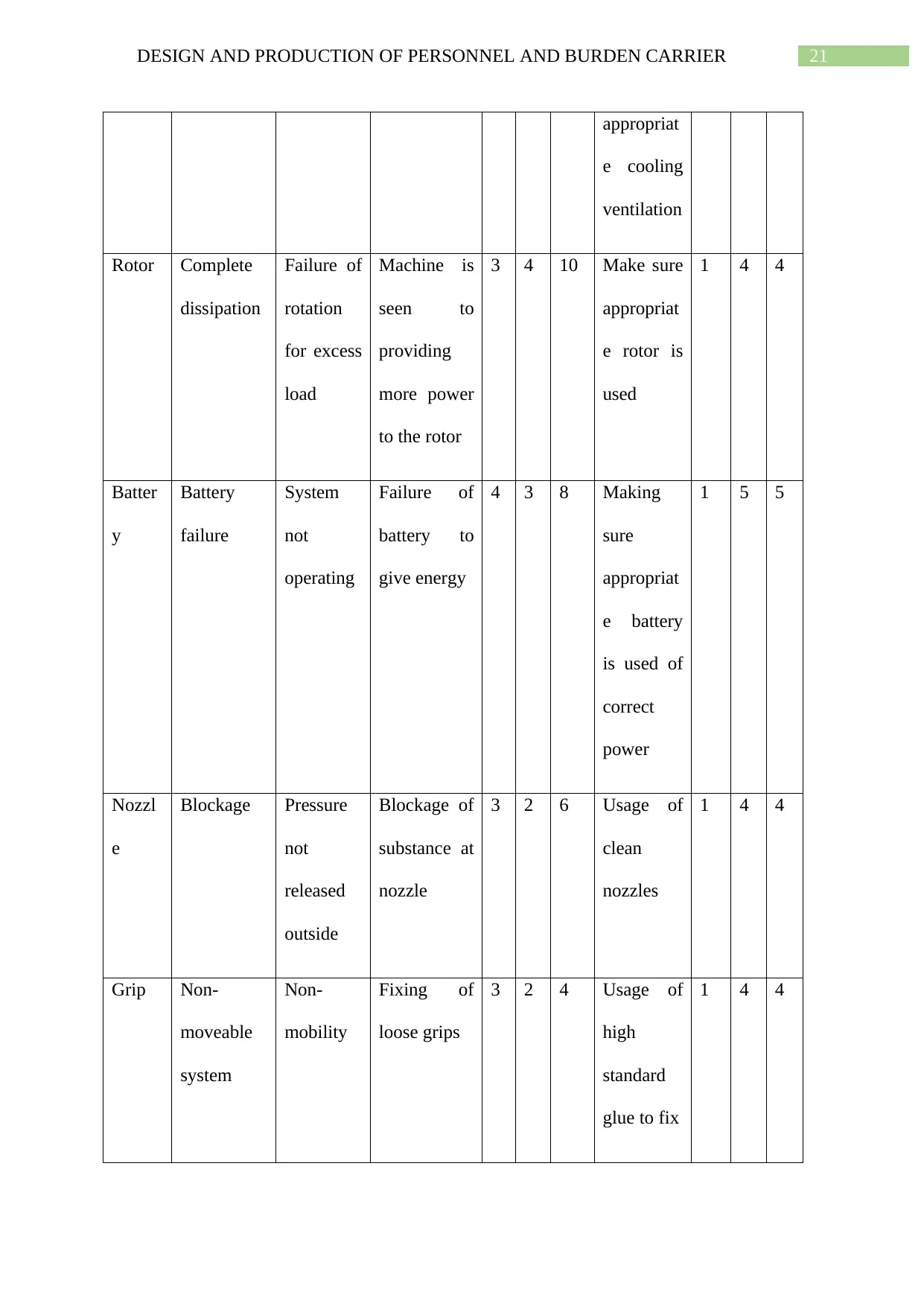
appropriat
e cooling
ventilation
Rotor Complete
dissipation
Failure of
rotation
for excess
load
Machine is
seen to
providing
more power
to the rotor
3 4 10 Make sure
appropriat
e rotor is
used
1 4 4
Batter
y
Battery
failure
System
not
operating
Failure of
battery to
give energy
4 3 8 Making
sure
appropriat
e battery
is used of
correct
power
1 5 5
Nozzl
e
Blockage Pressure
not
released
outside
Blockage of
substance at
nozzle
3 2 6 Usage of
clean
nozzles
1 4 4
Grip Non-
moveable
system
Non-
mobility
Fixing of
loose grips
3 2 4 Usage of
high
standard
glue to fix
1 4 4
Paraphrase This Document

Stage Post Causes
1 Very Marginal Ability of the system to work- Lower level of
improvement
2 Very little Ability of the system to work- improvement
which needs to be done
3 Medium Ability of the system to work properly-
involving some improvement in system
4 Quite much Not working- a good improvement must be
done
5 Most Not at all working- problem is major- needs
expert to be solved
Stage Descriptor Probability Description
1 Unlikely <0.019 Very likely to happen
2 Possible 0.020-0.049 At some time, probable
3 Likely 0.050-0.499 50-50 chances
4 Probable 0.500-0.999 Less chances to happen
5 Highly Probable 1.000 Least chances to happen
4.0 Supplier Choice and Evaluation
4.1 Identification of the Components, Elements and Parts
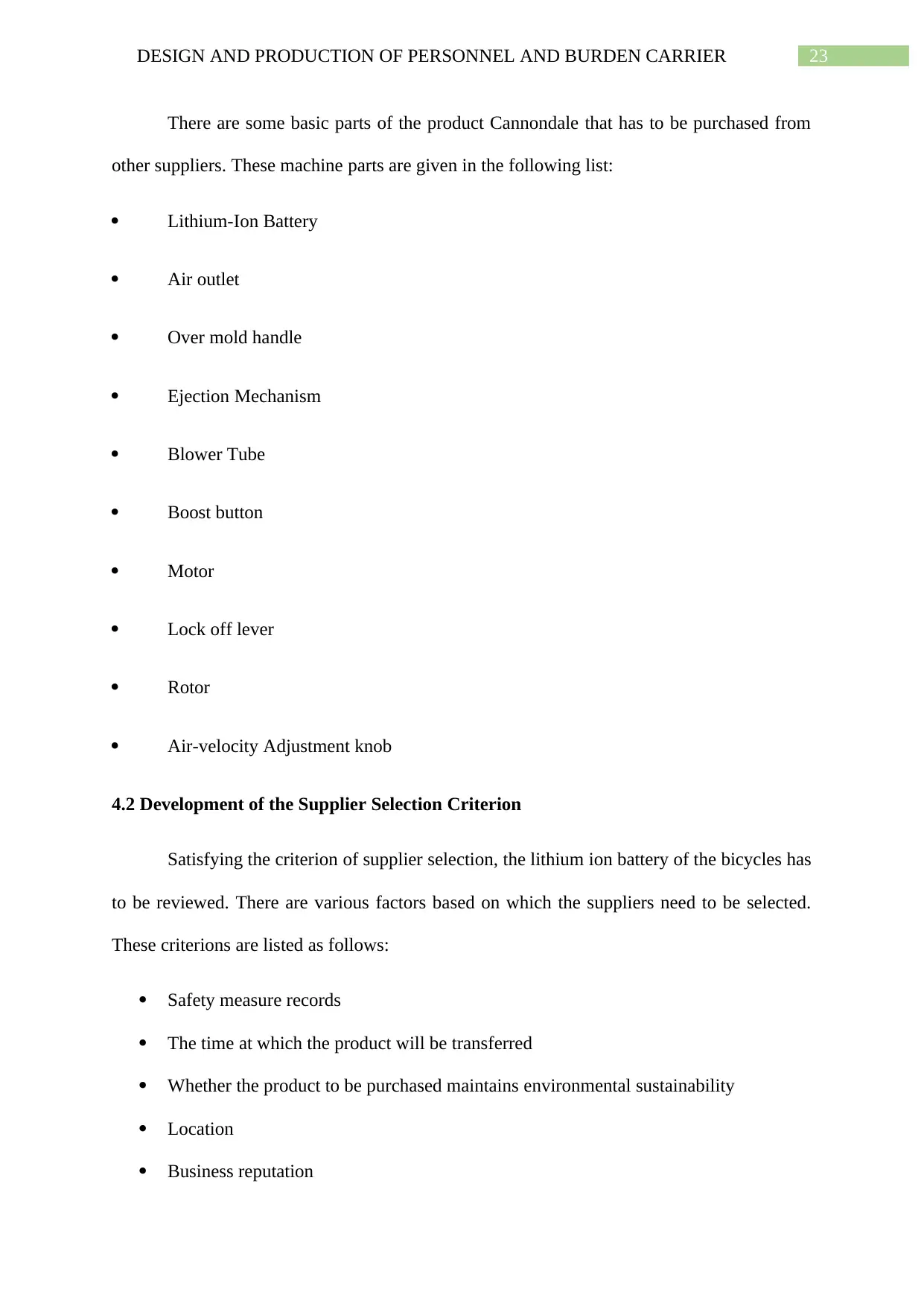
There are some basic parts of the product Cannondale that has to be purchased from
other suppliers. These machine parts are given in the following list:
Lithium-Ion Battery
Air outlet
Over mold handle
Ejection Mechanism
Blower Tube
Boost button
Motor
Lock off lever
Rotor
Air-velocity Adjustment knob
4.2 Development of the Supplier Selection Criterion
Satisfying the criterion of supplier selection, the lithium ion battery of the bicycles has
to be reviewed. There are various factors based on which the suppliers need to be selected.
These criterions are listed as follows:
Safety measure records
The time at which the product will be transferred
Whether the product to be purchased maintains environmental sustainability
Location
Business reputation
⊘ This is a preview!⊘
Do you want full access?
Subscribe today to unlock all pages.

Trusted by 1+ million students worldwide
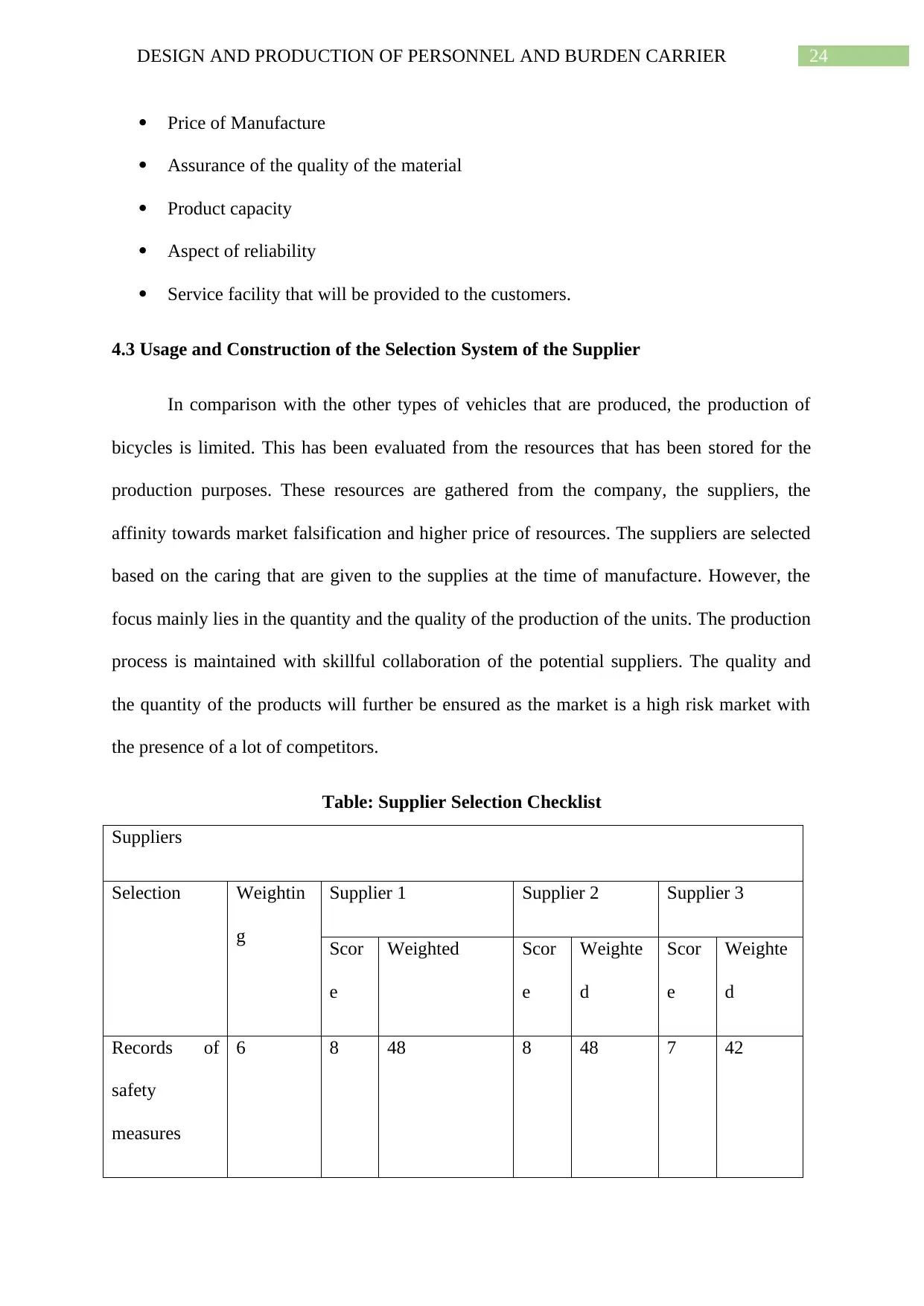
Price of Manufacture
Assurance of the quality of the material
Product capacity
Aspect of reliability
Service facility that will be provided to the customers.
4.3 Usage and Construction of the Selection System of the Supplier
In comparison with the other types of vehicles that are produced, the production of
bicycles is limited. This has been evaluated from the resources that has been stored for the
production purposes. These resources are gathered from the company, the suppliers, the
affinity towards market falsification and higher price of resources. The suppliers are selected
based on the caring that are given to the supplies at the time of manufacture. However, the
focus mainly lies in the quantity and the quality of the production of the units. The production
process is maintained with skillful collaboration of the potential suppliers. The quality and
the quantity of the products will further be ensured as the market is a high risk market with
the presence of a lot of competitors.
Table: Supplier Selection Checklist
Suppliers
Selection Weightin
g
Supplier 1 Supplier 2 Supplier 3
Scor
e
Weighted Scor
e
Weighte
d
Scor
e
Weighte
d
Records of
safety
measures
6 8 48 8 48 7 42
Paraphrase This Document
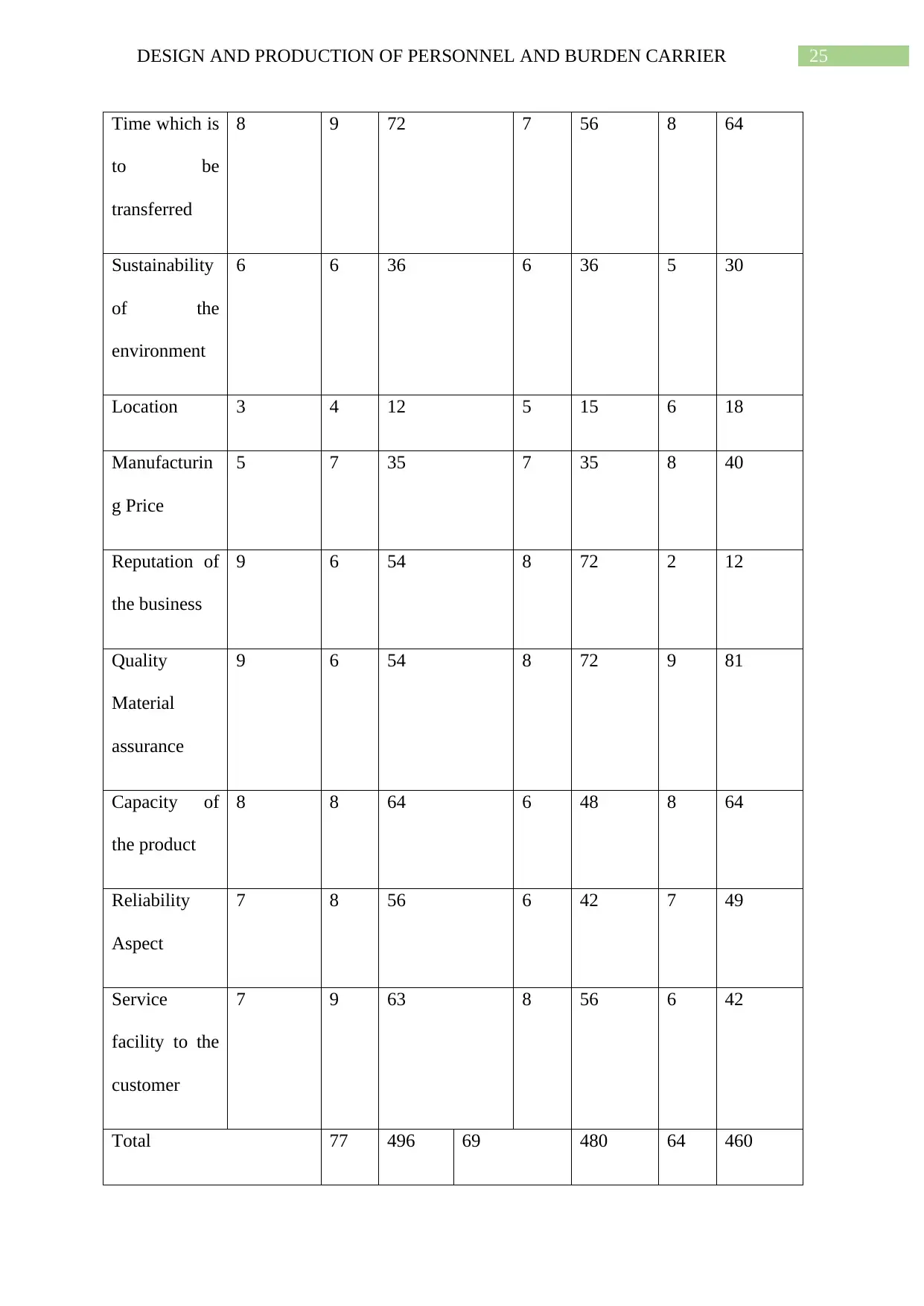
Time which is
to be
transferred
8 9 72 7 56 8 64
Sustainability
of the
environment
6 6 36 6 36 5 30
Location 3 4 12 5 15 6 18
Manufacturin
g Price
5 7 35 7 35 8 40
Reputation of
the business
9 6 54 8 72 2 12
Quality
Material
assurance
9 6 54 8 72 9 81
Capacity of
the product
8 8 64 6 48 8 64
Reliability
Aspect
7 8 56 6 42 7 49
Service
facility to the
customer
7 9 63 8 56 6 42
Total 77 496 69 480 64 460
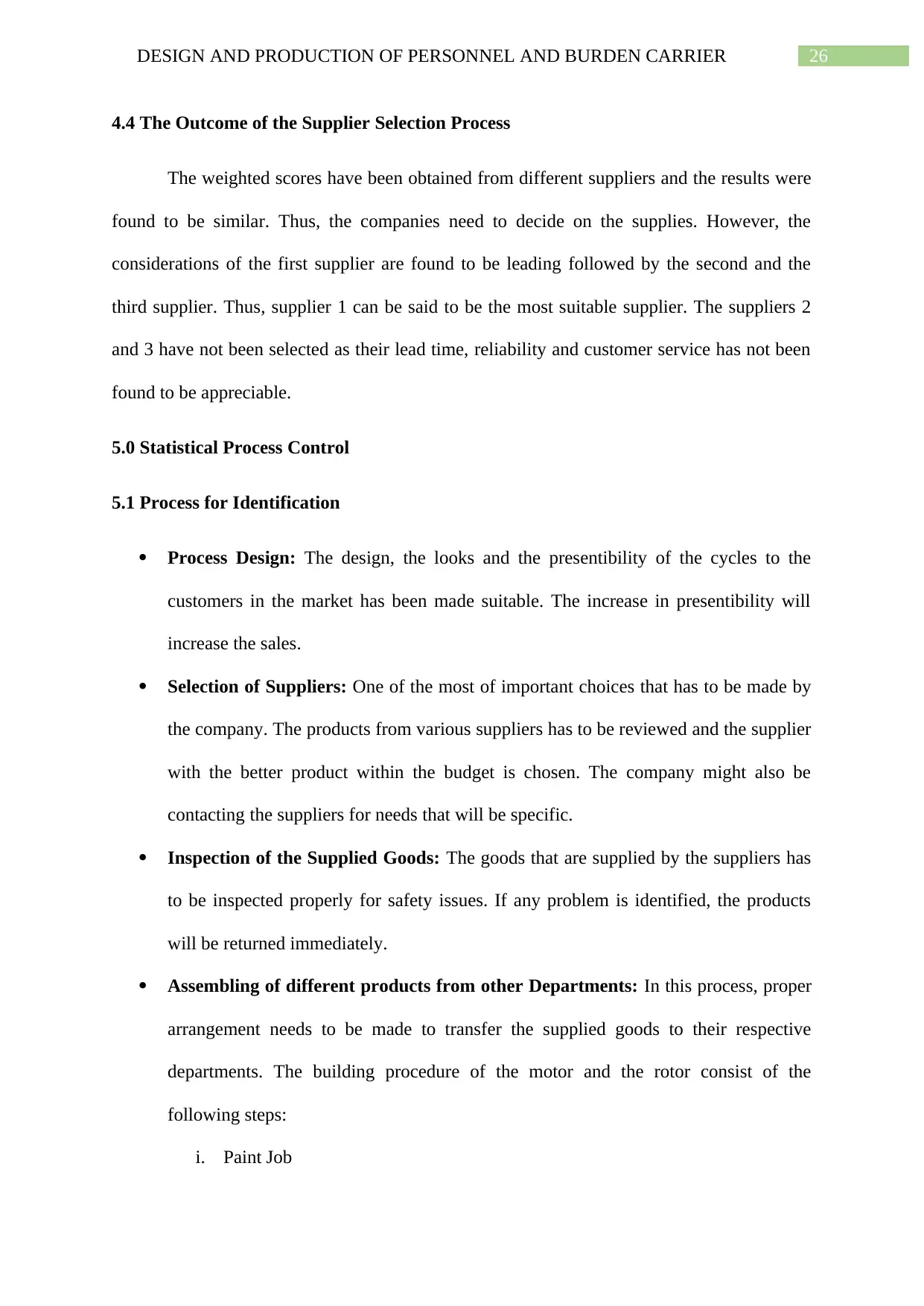
4.4 The Outcome of the Supplier Selection Process
The weighted scores have been obtained from different suppliers and the results were
found to be similar. Thus, the companies need to decide on the supplies. However, the
considerations of the first supplier are found to be leading followed by the second and the
third supplier. Thus, supplier 1 can be said to be the most suitable supplier. The suppliers 2
and 3 have not been selected as their lead time, reliability and customer service has not been
found to be appreciable.
5.0 Statistical Process Control
5.1 Process for Identification
Process Design: The design, the looks and the presentibility of the cycles to the
customers in the market has been made suitable. The increase in presentibility will
increase the sales.
Selection of Suppliers: One of the most of important choices that has to be made by
the company. The products from various suppliers has to be reviewed and the supplier
with the better product within the budget is chosen. The company might also be
contacting the suppliers for needs that will be specific.
Inspection of the Supplied Goods: The goods that are supplied by the suppliers has
to be inspected properly for safety issues. If any problem is identified, the products
will be returned immediately.
Assembling of different products from other Departments: In this process, proper
arrangement needs to be made to transfer the supplied goods to their respective
departments. The building procedure of the motor and the rotor consist of the
following steps:
i. Paint Job
⊘ This is a preview!⊘
Do you want full access?
Subscribe today to unlock all pages.

Trusted by 1+ million students worldwide
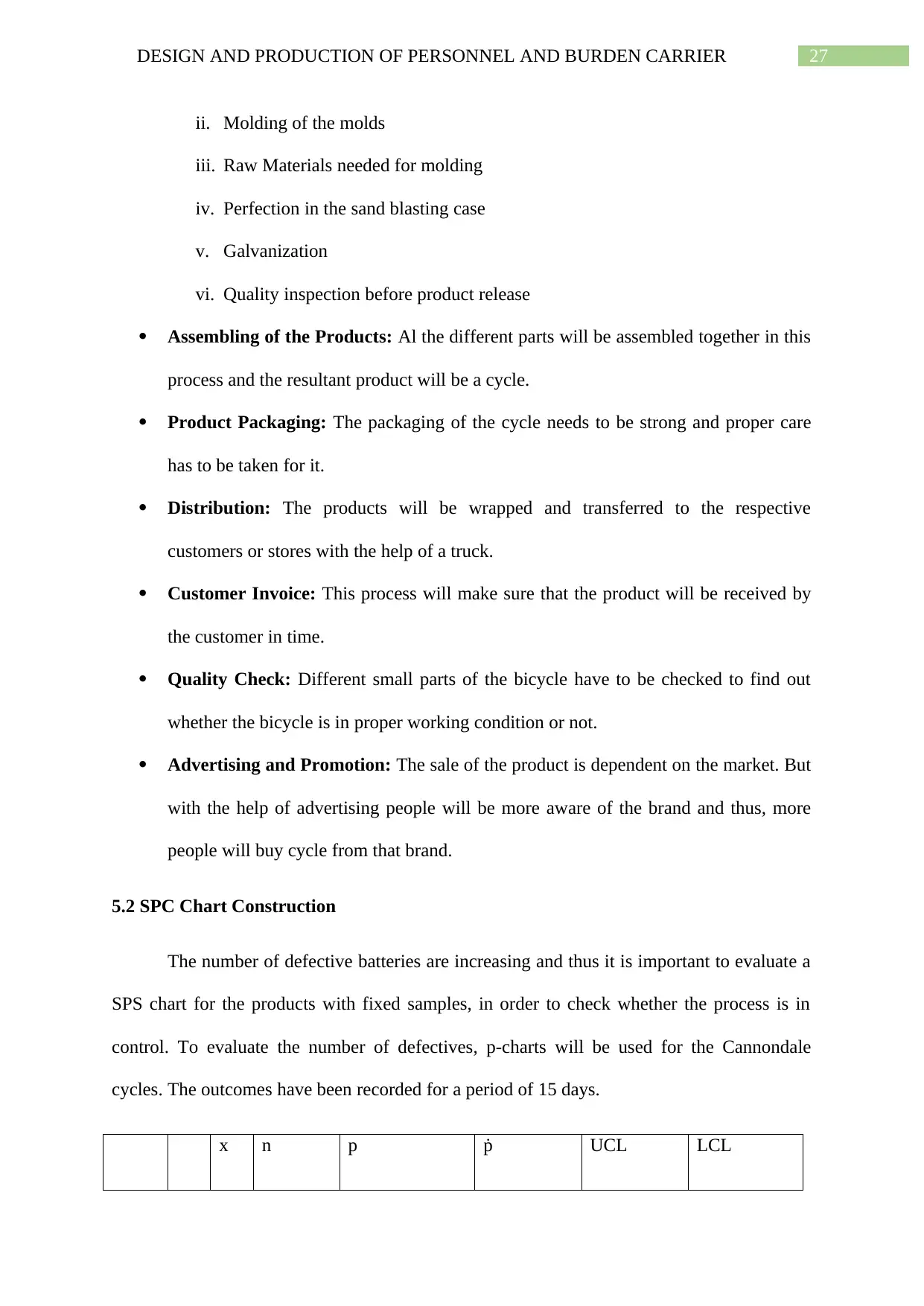
ii. Molding of the molds
iii. Raw Materials needed for molding
iv. Perfection in the sand blasting case
v. Galvanization
vi. Quality inspection before product release
Assembling of the Products: Al the different parts will be assembled together in this
process and the resultant product will be a cycle.
Product Packaging: The packaging of the cycle needs to be strong and proper care
has to be taken for it.
Distribution: The products will be wrapped and transferred to the respective
customers or stores with the help of a truck.
Customer Invoice: This process will make sure that the product will be received by
the customer in time.
Quality Check: Different small parts of the bicycle have to be checked to find out
whether the bicycle is in proper working condition or not.
Advertising and Promotion: The sale of the product is dependent on the market. But
with the help of advertising people will be more aware of the brand and thus, more
people will buy cycle from that brand.
5.2 SPC Chart Construction
The number of defective batteries are increasing and thus it is important to evaluate a
SPS chart for the products with fixed samples, in order to check whether the process is in
control. To evaluate the number of defectives, p-charts will be used for the Cannondale
cycles. The outcomes have been recorded for a period of 15 days.
x n p ṗ UCL LCL
Paraphrase This Document
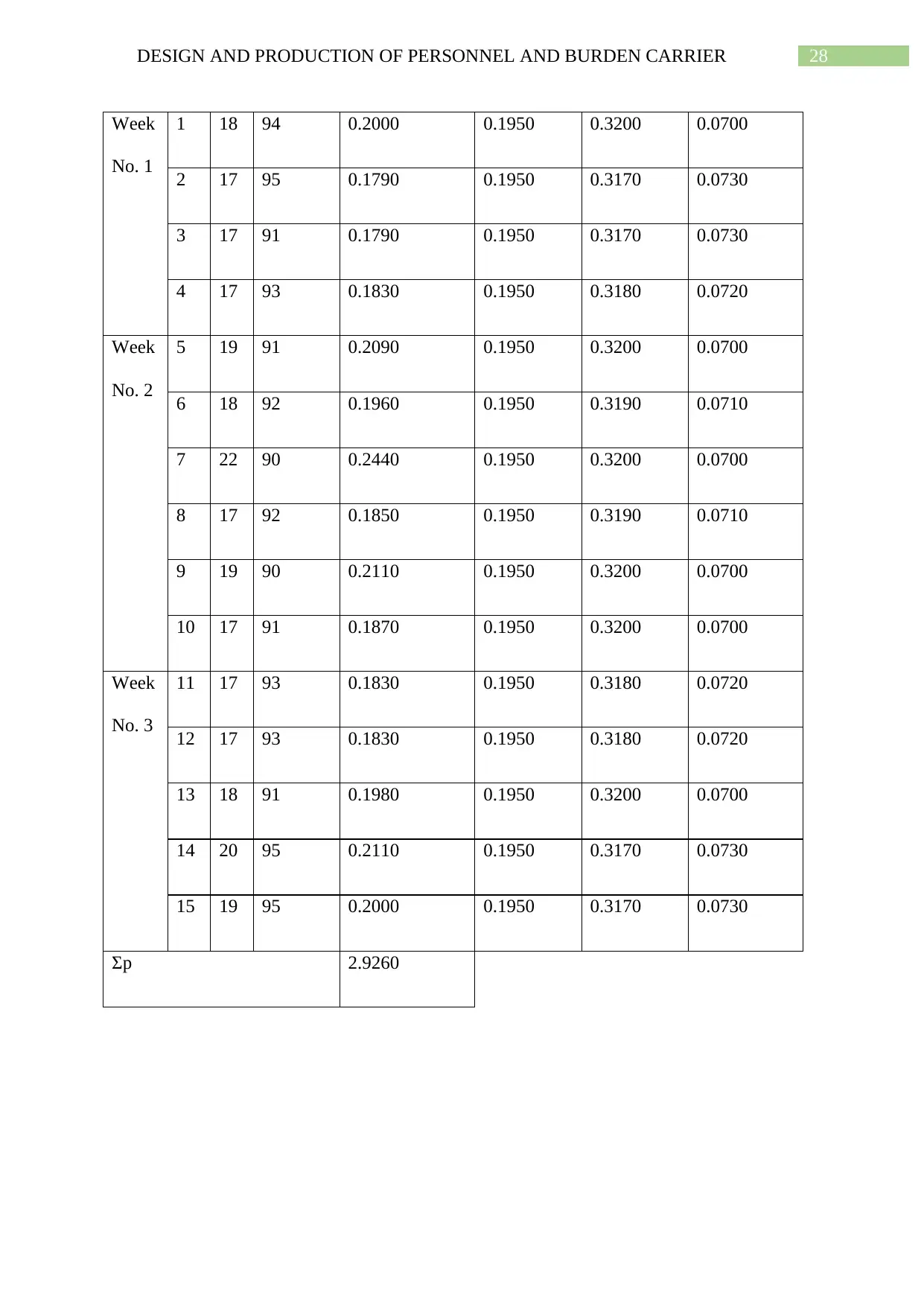
Week
No. 1
1 18 94 0.2000 0.1950 0.3200 0.0700
2 17 95 0.1790 0.1950 0.3170 0.0730
3 17 91 0.1790 0.1950 0.3170 0.0730
4 17 93 0.1830 0.1950 0.3180 0.0720
Week
No. 2
5 19 91 0.2090 0.1950 0.3200 0.0700
6 18 92 0.1960 0.1950 0.3190 0.0710
7 22 90 0.2440 0.1950 0.3200 0.0700
8 17 92 0.1850 0.1950 0.3190 0.0710
9 19 90 0.2110 0.1950 0.3200 0.0700
10 17 91 0.1870 0.1950 0.3200 0.0700
Week
No. 3
11 17 93 0.1830 0.1950 0.3180 0.0720
12 17 93 0.1830 0.1950 0.3180 0.0720
13 18 91 0.1980 0.1950 0.3200 0.0700
14 20 95 0.2110 0.1950 0.3170 0.0730
15 19 95 0.2000 0.1950 0.3170 0.0730
Ʃp 2.9260
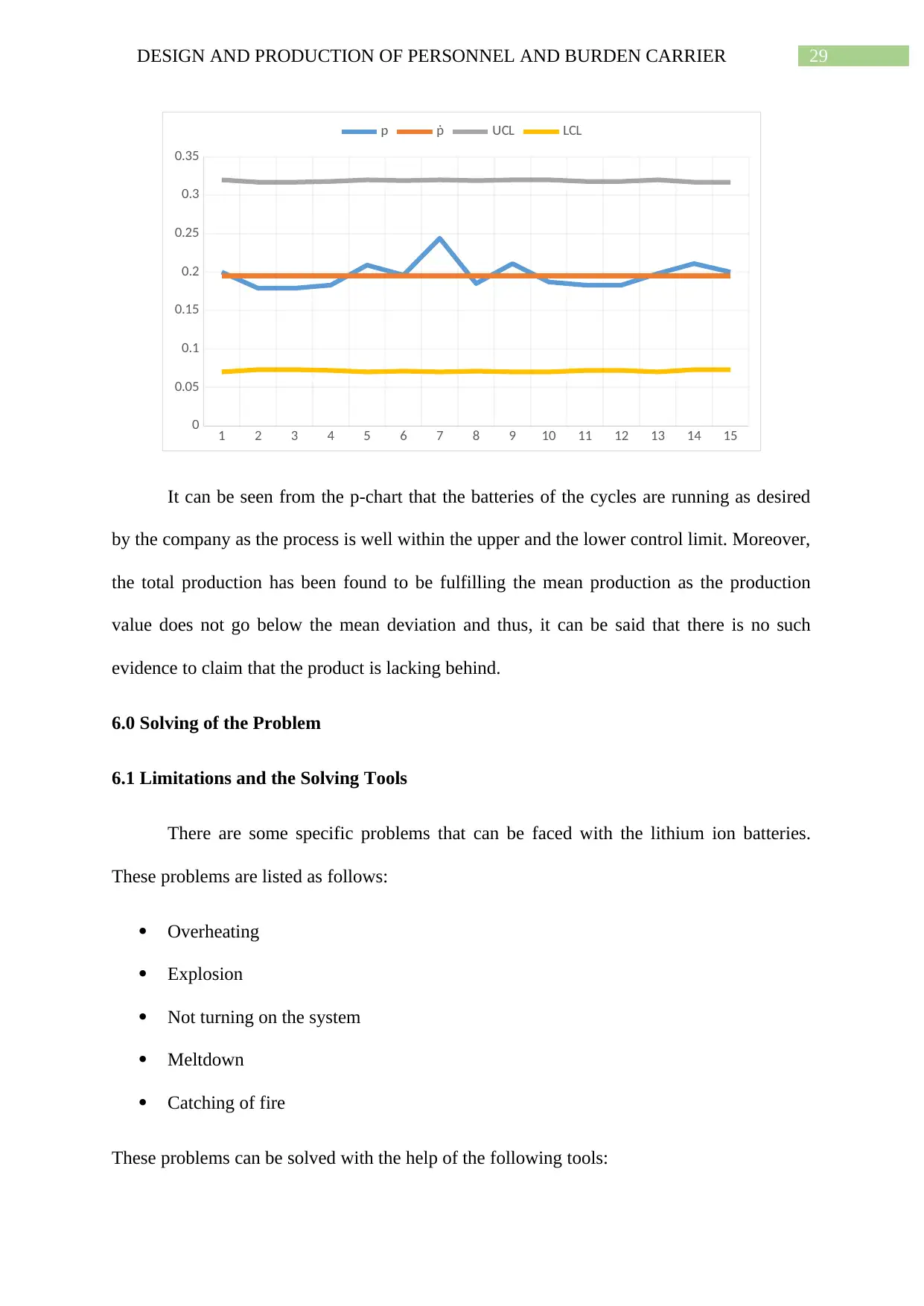
1 2 3 4 5 6 7 8 9 10 11 12 13 14 15
0
0.05
0.1
0.15
0.2
0.25
0.3
0.35
p ṗ UCL LCL
It can be seen from the p-chart that the batteries of the cycles are running as desired
by the company as the process is well within the upper and the lower control limit. Moreover,
the total production has been found to be fulfilling the mean production as the production
value does not go below the mean deviation and thus, it can be said that there is no such
evidence to claim that the product is lacking behind.
6.0 Solving of the Problem
6.1 Limitations and the Solving Tools
There are some specific problems that can be faced with the lithium ion batteries.
These problems are listed as follows:
Overheating
Explosion
Not turning on the system
Meltdown
Catching of fire
These problems can be solved with the help of the following tools:
⊘ This is a preview!⊘
Do you want full access?
Subscribe today to unlock all pages.

Trusted by 1+ million students worldwide

Cause and Effect
Why-Why diagram
Brainstorming
Gantt Chart to check the process flow
Pareto diagram
Compilation of working flowchart
Check sheet analysis
Limitations of the Remedies, Its Structures and Relevance
One major solution, from which various other problems can be solved is overheating
Analysis by the Experts (Brainstorming)
Shortcomings(s): Overheating
Rationale(s):
1. Over charged batteries installed
2. No proper battery installation
3. Machine usage being excessive
4. Liberation of High energy
5. Fault in batteries from suppliers
Answering Why! (The Why-Why Diagram)
Understanding of the situation and the reason that “why” this problem has happened
in the first place is the main objective of this process. When the same situation comes, the
same question will be asked to the individuals a number of times.
Paraphrase This Document
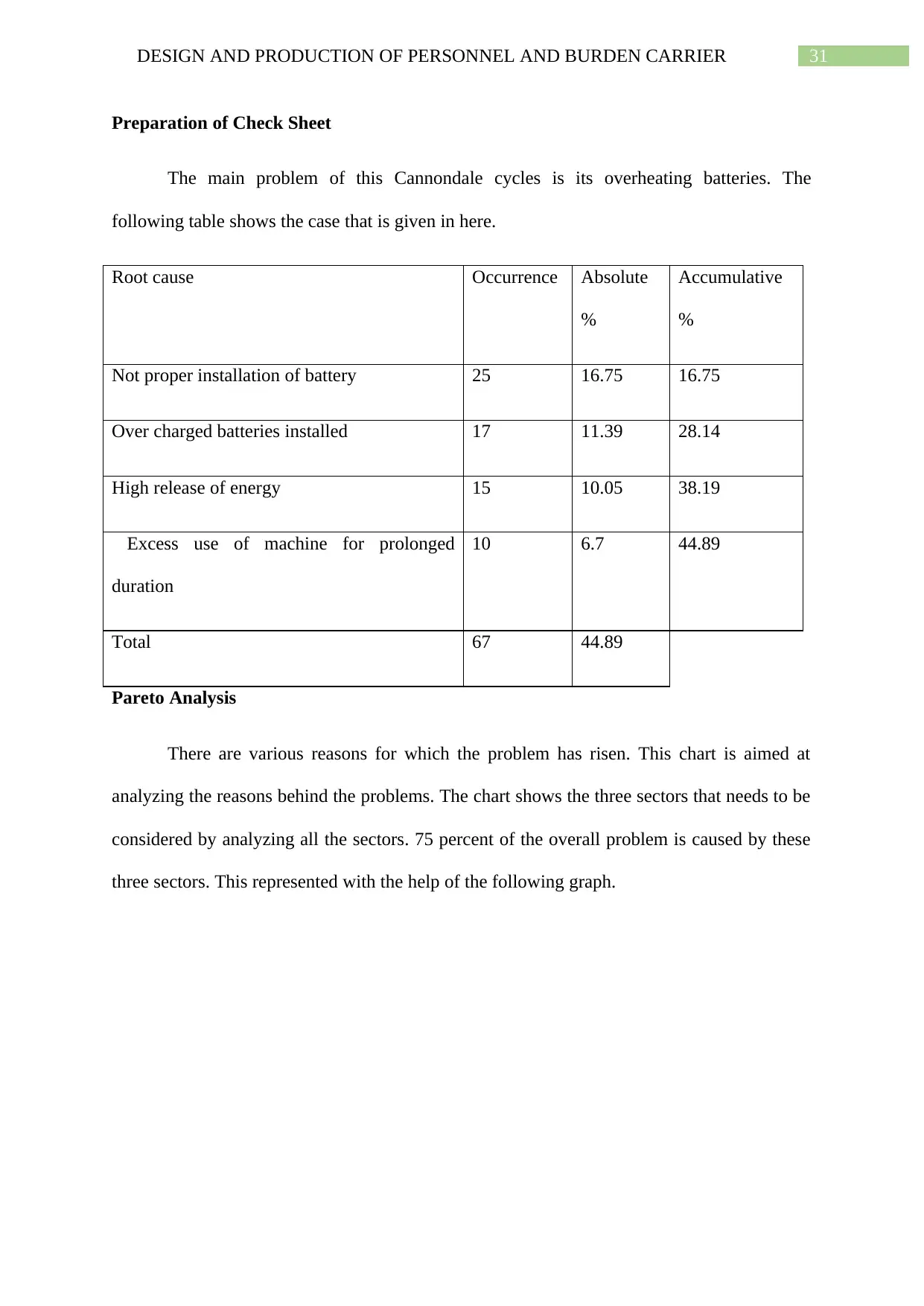
Preparation of Check Sheet
The main problem of this Cannondale cycles is its overheating batteries. The
following table shows the case that is given in here.
Root cause Occurrence Absolute
%
Accumulative
%
Not proper installation of battery 25 16.75 16.75
Over charged batteries installed 17 11.39 28.14
High release of energy 15 10.05 38.19
Excess use of machine for prolonged
duration
10 6.7 44.89
Total 67 44.89
Pareto Analysis
There are various reasons for which the problem has risen. This chart is aimed at
analyzing the reasons behind the problems. The chart shows the three sectors that needs to be
considered by analyzing all the sectors. 75 percent of the overall problem is caused by these
three sectors. This represented with the help of the following graph.
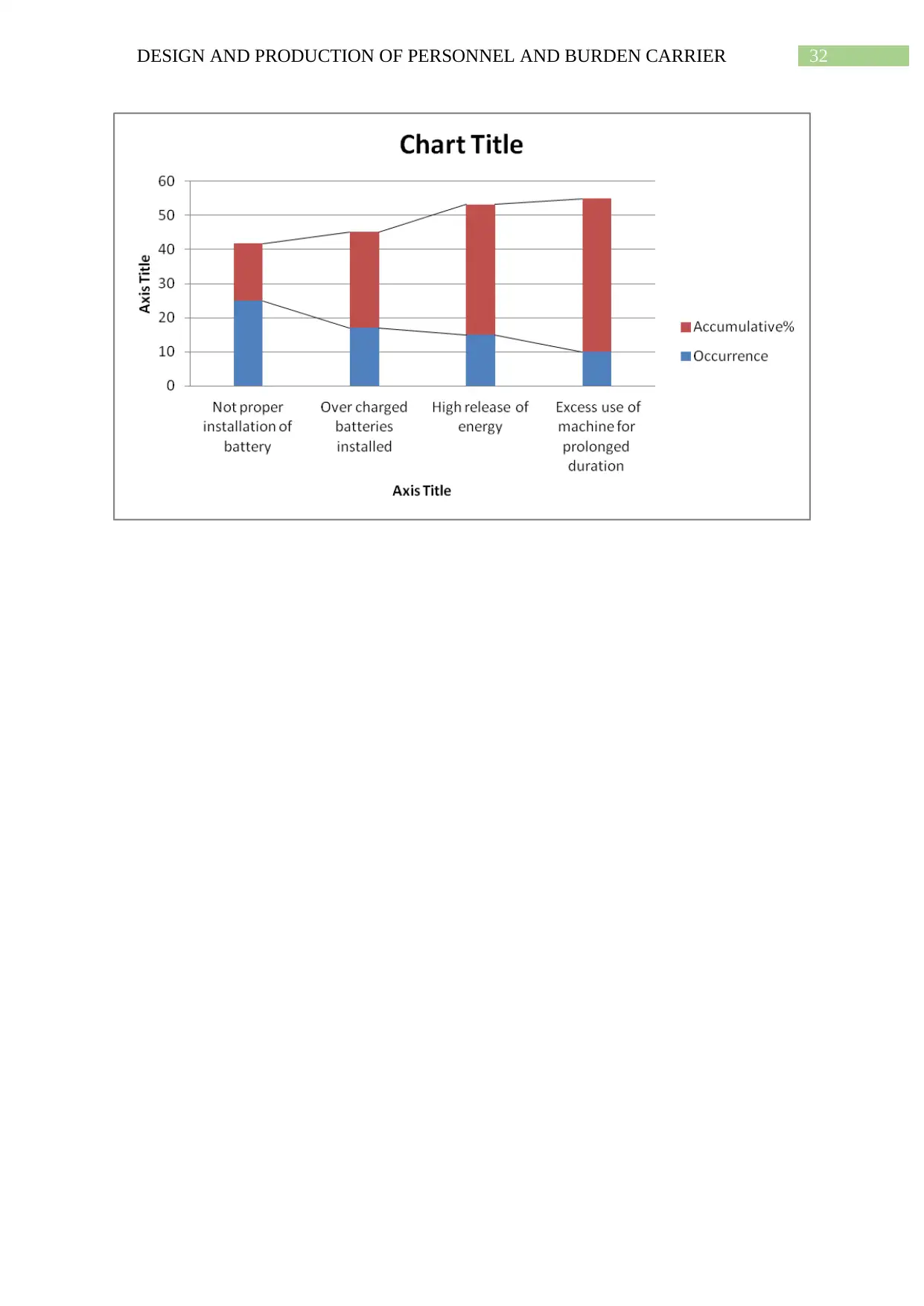
⊘ This is a preview!⊘
Do you want full access?
Subscribe today to unlock all pages.

Trusted by 1+ million students worldwide
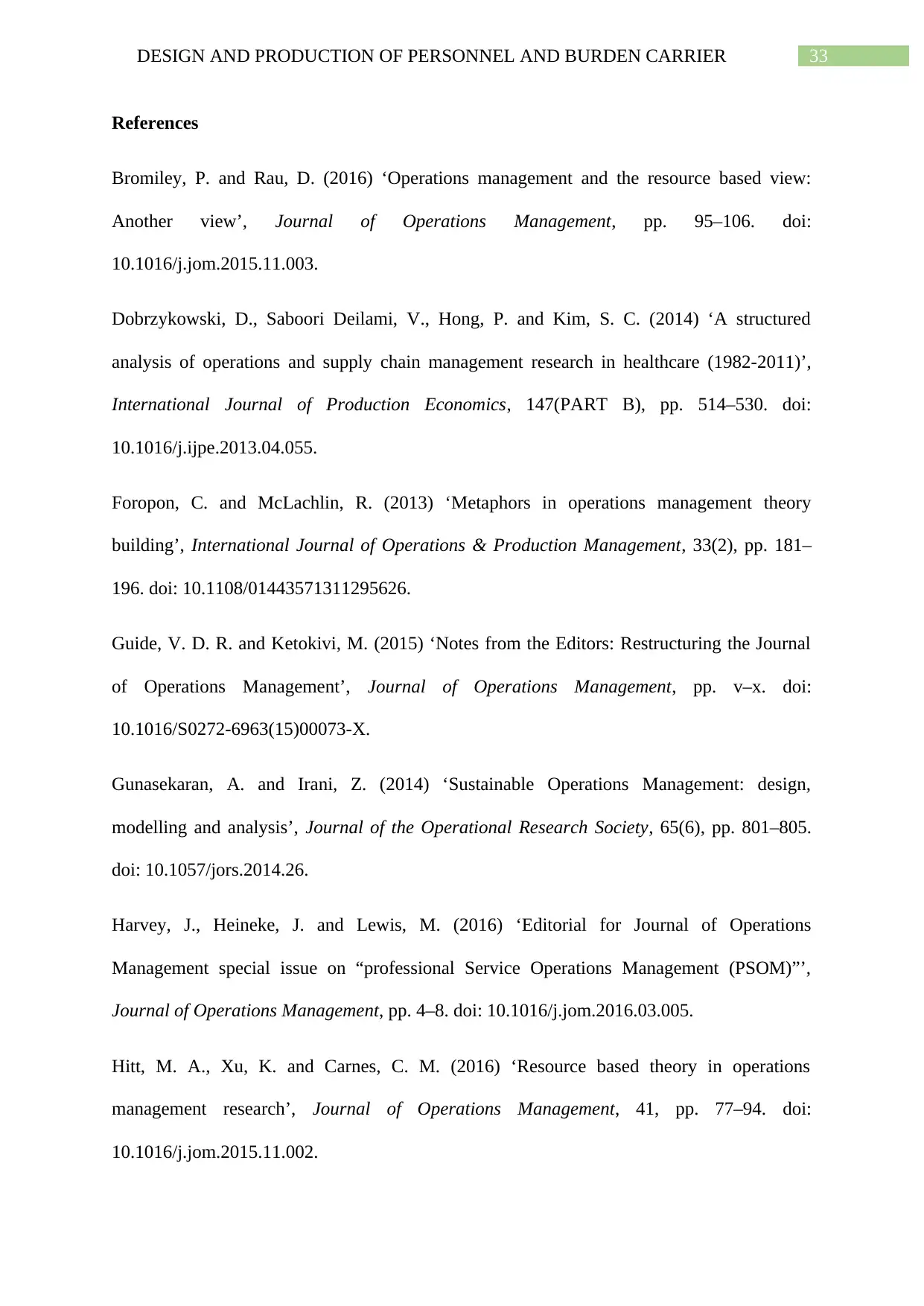
References
Bromiley, P. and Rau, D. (2016) ‘Operations management and the resource based view:
Another view’, Journal of Operations Management, pp. 95–106. doi:
10.1016/j.jom.2015.11.003.
Dobrzykowski, D., Saboori Deilami, V., Hong, P. and Kim, S. C. (2014) ‘A structured
analysis of operations and supply chain management research in healthcare (1982-2011)’,
International Journal of Production Economics, 147(PART B), pp. 514–530. doi:
10.1016/j.ijpe.2013.04.055.
Foropon, C. and McLachlin, R. (2013) ‘Metaphors in operations management theory
building’, International Journal of Operations & Production Management, 33(2), pp. 181–
196. doi: 10.1108/01443571311295626.
Guide, V. D. R. and Ketokivi, M. (2015) ‘Notes from the Editors: Restructuring the Journal
of Operations Management’, Journal of Operations Management, pp. v–x. doi:
10.1016/S0272-6963(15)00073-X.
Gunasekaran, A. and Irani, Z. (2014) ‘Sustainable Operations Management: design,
modelling and analysis’, Journal of the Operational Research Society, 65(6), pp. 801–805.
doi: 10.1057/jors.2014.26.
Harvey, J., Heineke, J. and Lewis, M. (2016) ‘Editorial for Journal of Operations
Management special issue on “professional Service Operations Management (PSOM)”’,
Journal of Operations Management, pp. 4–8. doi: 10.1016/j.jom.2016.03.005.
Hitt, M. A., Xu, K. and Carnes, C. M. (2016) ‘Resource based theory in operations
management research’, Journal of Operations Management, 41, pp. 77–94. doi:
10.1016/j.jom.2015.11.002.
Paraphrase This Document
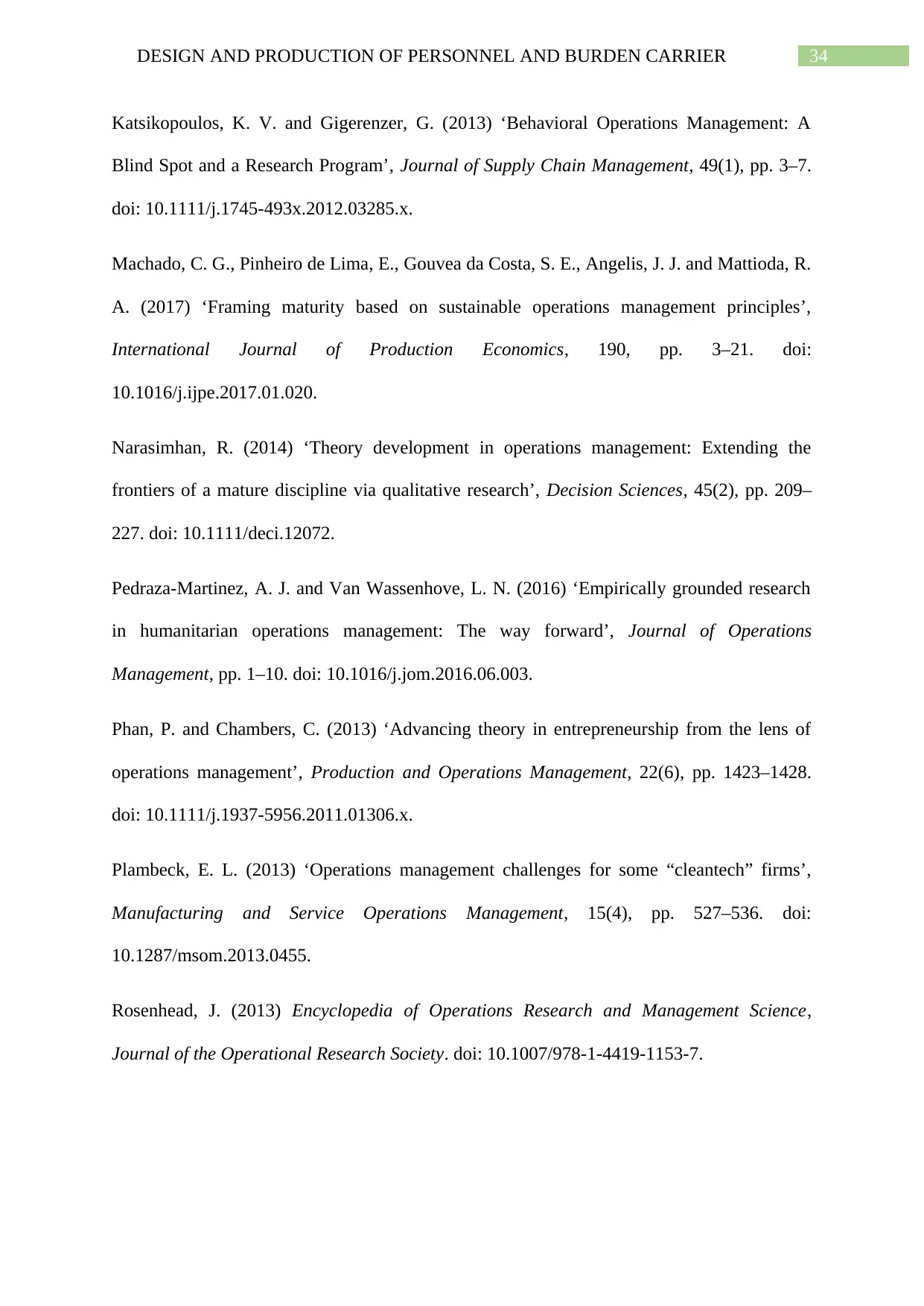
Katsikopoulos, K. V. and Gigerenzer, G. (2013) ‘Behavioral Operations Management: A
Blind Spot and a Research Program’, Journal of Supply Chain Management, 49(1), pp. 3–7.
doi: 10.1111/j.1745-493x.2012.03285.x.
Machado, C. G., Pinheiro de Lima, E., Gouvea da Costa, S. E., Angelis, J. J. and Mattioda, R.
A. (2017) ‘Framing maturity based on sustainable operations management principles’,
International Journal of Production Economics, 190, pp. 3–21. doi:
10.1016/j.ijpe.2017.01.020.
Narasimhan, R. (2014) ‘Theory development in operations management: Extending the
frontiers of a mature discipline via qualitative research’, Decision Sciences, 45(2), pp. 209–
227. doi: 10.1111/deci.12072.
Pedraza-Martinez, A. J. and Van Wassenhove, L. N. (2016) ‘Empirically grounded research
in humanitarian operations management: The way forward’, Journal of Operations
Management, pp. 1–10. doi: 10.1016/j.jom.2016.06.003.
Phan, P. and Chambers, C. (2013) ‘Advancing theory in entrepreneurship from the lens of
operations management’, Production and Operations Management, 22(6), pp. 1423–1428.
doi: 10.1111/j.1937-5956.2011.01306.x.
Plambeck, E. L. (2013) ‘Operations management challenges for some “cleantech” firms’,
Manufacturing and Service Operations Management, 15(4), pp. 527–536. doi:
10.1287/msom.2013.0455.
Rosenhead, J. (2013) Encyclopedia of Operations Research and Management Science,
Journal of the Operational Research Society. doi: 10.1007/978-1-4419-1153-7.
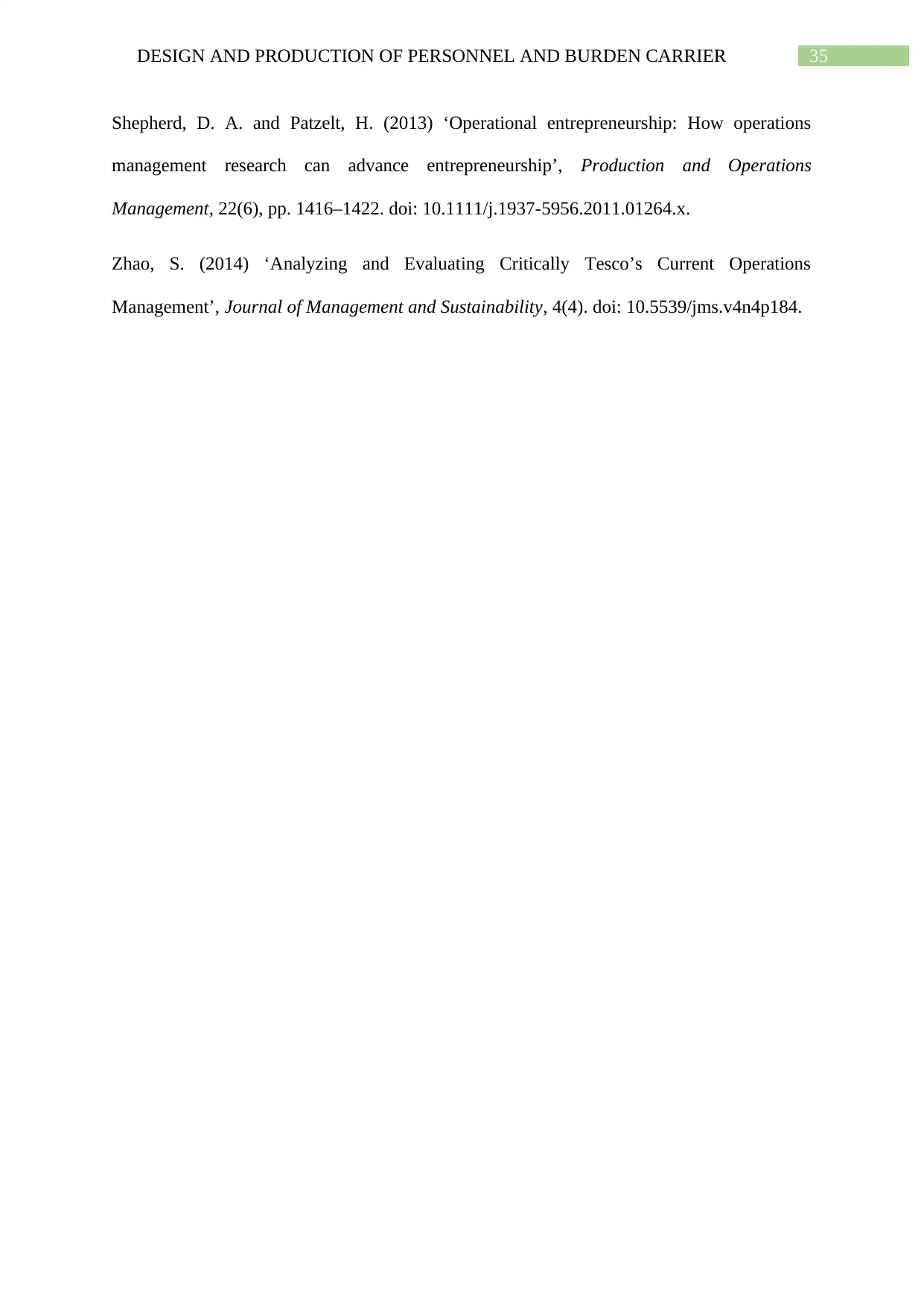
Shepherd, D. A. and Patzelt, H. (2013) ‘Operational entrepreneurship: How operations
management research can advance entrepreneurship’, Production and Operations
Management, 22(6), pp. 1416–1422. doi: 10.1111/j.1937-5956.2011.01264.x.
Zhao, S. (2014) ‘Analyzing and Evaluating Critically Tesco’s Current Operations
Management’, Journal of Management and Sustainability, 4(4). doi: 10.5539/jms.v4n4p184.
⊘ This is a preview!⊘
Do you want full access?
Subscribe today to unlock all pages.

Trusted by 1+ million students worldwide
Related Documents
Your All-in-One AI-Powered Toolkit for Academic Success.
+13062052269
info@desklib.com
Available 24*7 on WhatsApp / Email
![[object Object]](/_next/static/media/star-bottom.7253800d.svg)
© 2024 | Zucol Services PVT LTD | All rights reserved.





